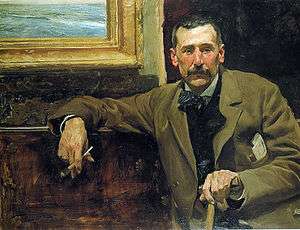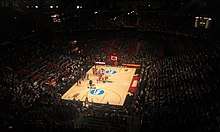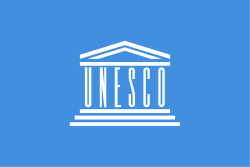Madrid
Madrid (/məˈdrɪd/, Spanish: [maˈðɾið])[n. 1] is the capital and most populous city of Spain. The city has almost 3.3 million[8] inhabitants and a metropolitan area population of approximately 6.5 million. It is the second-largest city in the European Union (EU), surpassed only by Berlin, and its monocentric metropolitan area is the second-largest in the EU, surpassed only by Paris.[9][10][11] The municipality covers 604.3 km2 (233.3 sq mi).[12]
Madrid | |
|---|---|
_1.jpg) 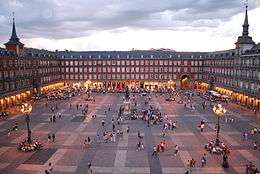    From upper left: Gran Vía, Plaza Mayor, business districts of AZCA and CTBA, Puerta de Alcalá and the Royal Palace, Almudena Cathedral | |
| Motto(s): "Fui sobre agua edificada, mis muros de fuego son. Esta es mi insignia y blasón" ("On water I was built, my walls are made of fire. This is my ensign and escutcheon") | |
 Madrid Location within Spain  Madrid Location within Europe | |
| Coordinates: 40°23′N 3°43′W | |
| Country | |
| Autonomous community | Community of Madrid |
| Founded | 9th century[1] |
| Government | |
| • Type | ayuntamiento |
| • Body | Ayuntamiento de Madrid |
| • Mayor | José Luis Martínez-Almeida (PP) |
| Area | |
| • Capital city and municipality | 604.31 km2 (233.33 sq mi) |
| Elevation | 667 m (2,188 ft) |
| Population (2018)[2] | |
| • Capital city and municipality | 3,223,334 |
| • Rank | 1st (2nd in EU) |
| • Density | 5,300/km2 (14,000/sq mi) |
| • Urban | 6,345,000 (2019)[3] |
| • Metro | 6,791,667 (2018)[4] |
| Demonym(s) | Madrilenian, Madrilene madrileño, -ña; matritense gato, -a |
| Time zone | UTC+1 (CET) |
| • Summer (DST) | UTC+2 (CEST) |
| Postal code | 28001–28080 |
| Area code(s) | +34 (ES) + 91 (M) |
| HDI (2018) | 0.928[5] – very high |
| Website | madrid |
Madrid lies on the River Manzanares in the centre of both the country and the Community of Madrid region, of which it is also the capital. As the capital city of Spain, seat of government, residence of the Spanish monarch, Madrid is also the political, economic and cultural centre of the country.[13] The mayor is José Luis Martínez-Almeida from the People's Party.
The Madrid urban agglomeration has the third-largest GDP[14] in the European Union and its influence in politics, education, entertainment, environment, media, fashion, science, culture, and the arts all contribute to its status as one of the world's major global cities.[15][16] Madrid is home to two world-famous football clubs, Real Madrid and Atlético Madrid. Due to its economic output, high standard of living, and market size, Madrid is considered the major financial centre[17] and the leading economic hub of the Iberian Peninsula and of Southern Europe.[18][19] It hosts the head offices of the vast majority of major Spanish companies, such as Telefónica, IAG or Repsol. Madrid is also the 10th most liveable city in the world according to Monocle magazine, in its 2017 index.[20]
Madrid houses the headquarters of the UN's World Tourism Organization (UNWTO), the Ibero-American General Secretariat (SEGIB), the Organization of Ibero-American States (OEI), and the Public Interest Oversight Board (PIOB). It also hosts major international regulators and promoters of the Spanish language: the Standing Committee of the Association of Spanish Language Academies, headquarters of the Royal Spanish Academy (RAE), the Instituto Cervantes and the Foundation of Urgent Spanish (Fundéu BBVA). Madrid organises fairs such as FITUR,[21] ARCO,[22] SIMO TCI[23] and the Madrid Fashion Week.[24]
While Madrid possesses modern infrastructure, it has preserved the look and feel of many of its historic neighbourhoods and streets. Its landmarks include the Plaza Mayor, the Royal Palace of Madrid; the Royal Theatre with its restored 1850 Opera House; the Buen Retiro Park, founded in 1631; the 19th-century National Library building (founded in 1712) containing some of Spain's historical archives; many national museums,[25] and the Golden Triangle of Art, located along the Paseo del Prado and comprising three art museums: Prado Museum, the Reina Sofía Museum, a museum of modern art, and the Thyssen-Bornemisza Museum, which complements the holdings of the other two museums.[26] Cibeles Palace and Fountain has become one of the monument symbols of the city.[27][28]
Etymology
There are three established theories regarding the origin of the toponym "Madrid" (all of them with problems when it comes to fully explain the phonetic evolution of the toponym along history), namely:[29]
History
Middle Ages

Although the site of modern-day Madrid has been occupied since prehistoric times,[31][32][33] and there are archaeological remains of Carpetani settlement, Roman villas,[34] a Visigoth basilica near the church of Santa María de la Almudena[35] and three Visigoth necropoleis near Casa de Campo, Tetúan and Vicálvaro,[36] the first historical document about the existence of an established settlement in Madrid dates from the Muslim age. At the second half of the 9th century,[37] Emir Muhammad I of Córdoba built a fortress on a headland near the river Manzanares,[38] as one of the many fortresses he ordered to be built on the border between Al-Andalus and the kingdoms of León and Castile, with the objective of protecting Toledo from the Christian invasions and also as a starting point for Muslim offensives. After the disintegration of the Caliphate of Córdoba, Madrid was integrated in the Taifa of Toledo.
With the surrender of Toledo to Alfonso VI of León and Castile, the city was conquered by Christians in 1085, and it was integrated into the kingdom of Castile as a property of the Crown.[39] The knight Ivan de Vargas, who distinguished himself in the conquest of Madrid, was the founder of the House of Vargas, from whom the common Spanish surname "Vargas" is derived. Following the conquest, Christians replaced Muslims in the occupation of the centre of the city, while Muslims and Jews settled in the suburbs. The city was confirmed as villa de realengo (linked to the Crown) in 1123, during the reign of Alfonso VII of León and Castile.[40] The 1123 Charter of Otorgamiento established the first explicit limits between Madrid and Segovia, namely the Puerto de El Berrueco and the Puerto de Lozoya.[41] Since 1188, Madrid won the right to be a city with representation in the courts of Castile. In 1202, Alfonso VIII of Castile gave Madrid its first charter to regulate the municipal council,[42] which was expanded in 1222 by Ferdinand III of Castile. The government system of the town was changed to a regimiento of 12 regidores by Alfonso XI of Castile on 6 January 1346.[43]
Since the mid-13th century and up to the late 14th century, the concejo of Madrid vied for the control of the Real de Manzanares territory against the concejo of Segovia, a powerful town north of the Sierra de Guadarrama mountain range, characterised by its repopulating prowess and its husbandry-based economy, contrasted by the agricultural and less competent in repopulation town of Madrid.[44] After the decline of Sepúlveda, another concejo north of the mountain range, Segovia had become a major actor south of the Guadarrama mountains, expanding across the Lozoya and Manzanares rivers to the north of Madrid and along the Guadarrama river course to its west.[44]
In 1309, the Courts of Castile convened at Madrid for the first time under Ferdinand IV of Castile, and later in 1329, 1339, 1391, 1393, 1419 and twice in 1435. Since the unification of the kingdoms of Spain under a common Crown, the Courts were convened in Madrid more often.
Modern Age
During the revolt of the Comuneros, led by Juan de Padilla, Madrid joined the revolt against Emperor Charles V of Germany and I of Spain, but after defeat at the Battle of Villalar, Madrid was besieged and occupied by the royal troops. However, Charles I was generous to the town and gave it the titles of Coronada (Crowned) and Imperial. When Francis I of France was captured at the battle of Pavia, he was imprisoned in Madrid. And in the village is dated the Treaty of Madrid of 1526 (later denounced by the French) that resolved their situation.[45]
Is seen in the foreground the banks of the Manzanares, crossed by the predecessors to the Segovia Bridge (in the first third), and the Toledo Bridge (further south, right), which was built in a monumental form years later. The most prominent building in the north (left) is the Alcázar, which was part of the walled circuit and which would undergo several fires until the fatal one in 1734 that almost completely destroyed it and was replaced by the current Palacio Real. The following churches are seen in the village (from left to right: San Gil, San Juan, Santiago, San Salvador, Iglesia de San Miguel de los Octoes, San Nicolás, Santa María, San Justo, San Pedro, Capilla del Obispo, San Andrés and, outside the walls, San Francisco), that do not yet have even the profile of domes and chapiters by which they would be characterised in the following centuries. Outside the walls and on the river, there is a craft facility dedicated to the treatment of hides: the Pozacho Tanneries. The recent installation of the court imposed a regalía de aposento tax on private houses, which produced all kinds of resistance including, most notably, the construction of Casas a la malicia.[46]
The number of urban inhabitants grew from 4,060 in the year 1530 to 37,500 in the year 1594. The poor population of the court was composed of ex-soldiers, foreigners, rogues and Ruanes, dissatisfied with the lack of food and high prices. In June 1561 Philip II of Spain set his court in Madrid, installing it in the old alcázar.[47] Thanks to this, the city of Madrid became the political centre of the monarchy, being the capital of Spain except for a short period between 1601 and 1606 (Philip III's reign), in which the Court was relocated to Valladolid. This fact was decisive for the evolution of the city and influenced its fate. Thus, during the rest of the reign of Philip II, the population boomed, going up from about 18,000 in 1561 to 80,000 in 1598.[48]
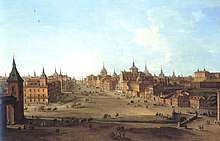
During the reign of Philip III and Philip IV, Madrid saw a period of exceptional cultural brilliance, with the presence of geniuses such as Miguel de Cervantes, Diego Velázquez, Francisco de Quevedo and Lope de Vega.[49]
The death of Charles II of Spain resulted in the War of the Spanish succession. The city supported the claim of Philip of Anjou as Philip V. While the city was occupied in 1706 by a Portuguese army, who proclaimed king the Archduke Charles of Austria under the name of Charles III, and again in 1710, it remained loyal to Philip V.
Philip V built the Royal Palace, the Royal Tapestry Factory and the main Royal Academies.[50] But the most important Bourbon was King Charles III of Spain, who was known as "the best mayor of Madrid". Charles III took upon himself the feat of transforming Madrid into a capital worthy of this category. He ordered the construction of sewers, street lighting, cemeteries outside the city, and many monuments (Puerta de Alcalá, Cibeles Fountain), and cultural institutions (El Prado Museum, Royal Botanic Gardens, Royal Observatory, etc.). Despite being known as one of the greatest benefactors of Madrid, his beginnings were not entirely peaceful, as in 1766 he had to overcome the Esquilache Riots, a traditionalist revolt instigated by the nobility and clergy against his reformist intentions, demanding the repeal of the clothing decree ordering the shortening of the layers and the prohibition of the use of hats that hide the face, with the aim of reducing crime in the city.[51] The reign of Charles IV of Spain is not very meaningful to Madrid, except for the presence of Goya in the Court, who portrayed the popular and courtly life of the city.
Peninsular War
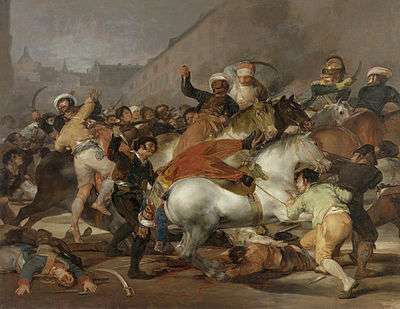
On 27 October 1807, Charles IV and Napoleon I signed the Treaty of Fontainebleau, which allowed the passage of French troops through Spanish territory to join the Spanish troops and invade Portugal, which had refused to obey the order of international blockade against England. As this was happening, there was the Mutiny of Aranjuez (17 March 1808), by which the crown prince, Ferdinand VII, replaced his father as king. However, when Ferdinand VII returned to Madrid, the city was already occupied by Joachim-Napoléon Murat, so that both the king and his father were virtually prisoners of the French army. Napoleon, taking advantage of the weakness of the Spanish Bourbons, forced both, first the father then the son, to join him in Bayonne, where Ferdinand arrived on 20 April.
In the absence of the two kings, the situation became more and more tense in the capital. On 2 May, a crowd began to gather at the Royal Palace. The crowd saw the French soldiers pulled out of the palace to the royal family members who were still in the palace. Immediately, the crowd launched an assault on the floats. The fight lasted hours and spread throughout Madrid. Subsequent repression was brutal. In the Paseo del Prado and in the fields of La Moncloa hundreds of patriots were shot due to Murat's order against "Spanish all carrying arms". Paintings such as The Third of May 1808 by Goya reflect the repression that ended the popular uprising on 2 May.[52]
Capital of the Liberal State
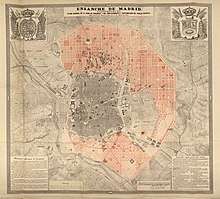
The Peninsular War against Napoleon, despite the last absolutist claims during the reign of Ferdinand VII, gave birth to a new country with a liberal and bourgeois character, open to influences coming from the rest of Europe. Madrid, the capital of Spain, experienced like no other city the changes caused by this opening and filled with theatres, cafés and newspapers. Madrid was frequently altered by revolutionary outbreaks and pronouncements, such as the 1854 Vicalvarada, led by General Leopoldo O'Donnell and initiating the progressive biennium. However, in the early 20th century Madrid looked more like a small town than a modern city.
During the first third of the 20th century the population nearly doubled, reaching more than 850,000 inhabitants. New suburbs such as Las Ventas, Tetuán and El Carmen became the homes of the influx of workers, while Ensanche became a middle-class neighbourhood of Madrid.[53]
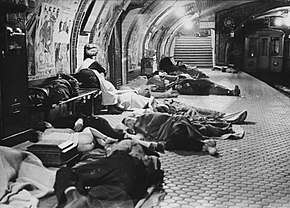
Second Republic and Civil War
The Spanish Constitution of 1931 was the first legislated on the state capital, setting it explicitly in Madrid. During the 1930s, Madrid enjoyed "great vitality"; it was demographically young, but also young in the sense of its relation with the modernity.[54] During this time the prolongation of the Paseo de la Castellana towards the North was projected.[55] The proclamation of the Republic slowed down the building of new housing.[56] The tertiary sector gave thrust to the economy.[57] Illiteracy rates were down to below 20%, and the city's cultural life grew notably during the so-called Silver Age of Spanish Culture; the sales of newspaper also increased.[58] Anti-clericalism and Catholicism lived side by side in Madrid; the burning of convents initiated after riots in the city in May 1931 worsened the political environment.[59] The 1934 insurrection largely failed in Madrid.[60]
Madrid was one of the most heavily affected cities of Spain in the Civil War (1936–1939). The city was a stronghold of the Republican faction from July 1936 and became an international symbol of anti-fascist struggle during the conflict.[61] Its western suburbs were the scene of an all-out battle in November 1936 and during the Civil War the city was also bombed by aeroplanes.[62] The city fell to the Francoists in March 1939.
Francoist dictatorship

A staple of the Post-war Madrid (Madrid de la posguerra) was the widespread use of ration coupons.[63] Meat and fish consumption was scarce, and starvation and lack of proteins were a cause of high mortality.[64] As the protracted right-wing despise towards the city nurtured during the Second Republic turned up to eleven during the war, the victors toyed with the possibility of moving the capital elsewhere (most notably to Seville), yet such plans did not materialize, and the Francoist regime conducted then an attempt to resignificate the city, stemming from the Spanish Imperial ideal.[65]
The intense demographic growth experienced by the city via mass immigration from the rural areas of the country led to the construction of plenty of housing in the peripheral areas of the city to absorb the new population (reinforcing the processes of social polarization of the city),[66] initially comprising substandard housing (with as many as 50,000 shacks scattered around the city by 1956).[67] A transitional planning intended to temporarily replace the shanty towns were the poblados de absorción, introduced since the mid-1950s in locations such as Canillas, San Fermín, Caño Roto, Villaverde, Pan Bendito, Zofío and Fuencarral, aiming to work as a sort of "high-end" shacks (with the destinataries participating in the construction of their own housing) but under the aegis of a wider coordinated urban planning.[68]
The municipality grew through the annexation of neighbouring municipalities, achieving the present extension of 607 km2 (234.36 sq mi). The south of Madrid became very industrialised, and there were massive migrations from rural areas of Spain into the city. Madrid's newly built north-western districts became the home of the new thriving middle class that appeared as result of the 1960s Spanish economic boom, while the south-eastern periphery became an extensive working-class settlement, which was the base for an active cultural and political reform.[62]
Recent history
After the death of Franco and the start of the democratic regime, the 1978 constitution confirmed Madrid as the capital of Spain. The 1979 municipal election brought Madrid's first democratic mayor since the Second Republic.
Madrid was the scene of some of the most important events of the time, such as the mass demonstrations of support for democracy after the failed coup, 23-F, on 23 February 1981. The first democratic mayors belonged to the centre-left PSOE (Enrique Tierno Galván, Juan Barranco Gallardo). Since the late 1970s and through the 1980s Madrid became the center of the cultural movement known as la Movida. Conversely, just like in the rest of the country, a heroin crisis took a toll in the poor neighborhoods of Madrid in the 1980s.[69]
Benefiting from increasing prosperity in the 1980s and 1990s, the capital city of Spain consolidated its position as an important economic, cultural, industrial, educational, and technological centre on the European continent.[62] During the mandate as Mayor of José María Álvarez del Manzano construction of traffic tunnels below the city proliferated.[70] The following administrations, also conservative, led by Alberto Ruiz-Gallardón and Ana Botella launched three unsuccessful bids for the 2012, 2016 and 2020 Summer Olympics.[71] By 2005, Madrid was the leading European destination for migrants from developing countries, as well as the largest employer of non-European workforce in Spain.[72] Madrid was a centre of the anti-austerity protests that erupted in Spain in 2011. As consequence of the spillover of the 2008 financial and mortgage crisis, Madrid has been affected by the increasing number of second-hand homes held by banks and house evictions.[73] The mandate of left-wing Mayor Manuela Carmena (2015–2019) delivered the renaturalization of the course of the Manzanares across the city.
Since the late 2010s, the challenges the city faces include the increasingly unaffordable rental prices (often in parallel with the gentrification and the spike of tourist apartments in the city centre) and the profusion of betting shops in working-class areas, equalled to an "epidemics" among the young people.[74][75]
Geography
Location
.jpg)
Madrid lies on the southern Meseta Central, 60 km south of the Guadarrama mountain range and straddling the Jarama and Manzanares river sub-drainage basins, in the wider Tagus River catchment area. There is a considerable difference in altitude within the city proper ranging from the 700 m (2,297 ft) around Plaza de Castilla in the north of city to the 570 m (1,870 ft) around La China wastewater treatment plant on the Manzanares' riverbanks, near the latter's confluence with the Fuente Castellana thalweg in the south of the city.[76] The Monte de El Pardo (a protected forested area covering over a quarter of the municipality) reaches its top altitude (843 m (2,766 ft)) on its perimeter, in the slopes surrounding El Pardo reservoir located at the north-western end of the municipality, in the Fuencarral-El Pardo district.[77]
The oldest urban core is located on the hills next to the left bank of the Manzanares River.[78] The city grew to the east, reaching the Fuente Castellana Creek (now the Paseo de la Castellana), and further east reaching the Abroñigal Creek (now the M-30).[78] The city also grew through the annexation of neighbouring urban settlements,[78] including those to the South West on the right bank of the Manzanares.
Climate
Madrid has an inland Mediterranean climate (Köppen Csa)[79] in the western half of the city transitioning to a semi-arid climate (BSk) in the eastern half.[80] Winters are cool due to its altitude, which is approximately 667 m (2,188 ft) above sea level, including sporadic snowfalls and frequent frosts between December and February. Summers are hot, in the warmest month, July, average temperatures during the day range from 32 to 34 °C (90 to 93 °F) depending on location, with maxima commonly climbing over 35 °C (95 °F) during the frequent heat waves. Due to Madrid's altitude and dry climate, diurnal ranges are often significant during the summer. The highest recorded temperature was on 24 July 1995, at 42.2 °C (108.0 °F), and the lowest recorded temperature was on 16 January 1945 at −15.3 °C (4.5 °F). These records were registered at the airport, in the eastern side of the city.[81] Precipitation is concentrated in the autumn and spring, and, together with Athens which has similar annual precipitation, Madrid is the driest capital in Europe. It is particularly sparse during the summer, taking the form of about two showers and/or thunderstorms during the season.
| Climate data for Madrid (667 m), Buen Retiro Park in the city centre (1981–2010) | |||||||||||||
|---|---|---|---|---|---|---|---|---|---|---|---|---|---|
| Month | Jan | Feb | Mar | Apr | May | Jun | Jul | Aug | Sep | Oct | Nov | Dec | Year |
| Record high °C (°F) | 20.1 (68.2) |
22.0 (71.6) |
26.7 (80.1) |
30.1 (86.2) |
35.5 (95.9) |
39.3 (102.7) |
40.0 (104.0) |
40.3 (104.5) |
38.9 (102.0) |
28.7 (83.7) |
22.7 (72.9) |
18.6 (65.5) |
40.3 (104.5) |
| Average high °C (°F) | 9.8 (49.6) |
12.0 (53.6) |
16.3 (61.3) |
18.2 (64.8) |
22.2 (72.0) |
28.2 (82.8) |
32.1 (89.8) |
31.3 (88.3) |
26.4 (79.5) |
19.4 (66.9) |
13.5 (56.3) |
10.0 (50.0) |
19.9 (67.8) |
| Daily mean °C (°F) | 6.3 (43.3) |
7.9 (46.2) |
11.2 (52.2) |
12.9 (55.2) |
16.7 (62.1) |
22.2 (72.0) |
25.6 (78.1) |
25.1 (77.2) |
20.9 (69.6) |
15.1 (59.2) |
9.9 (49.8) |
6.9 (44.4) |
15.0 (59.0) |
| Average low °C (°F) | 2.7 (36.9) |
3.7 (38.7) |
6.2 (43.2) |
7.7 (45.9) |
11.3 (52.3) |
16.1 (61.0) |
19.0 (66.2) |
18.8 (65.8) |
15.4 (59.7) |
10.7 (51.3) |
6.3 (43.3) |
3.6 (38.5) |
10.1 (50.2) |
| Record low °C (°F) | −7.8 (18.0) |
−7.5 (18.5) |
−4.5 (23.9) |
−1.5 (29.3) |
3.3 (37.9) |
7 (45) |
9.8 (49.6) |
8.6 (47.5) |
4.1 (39.4) |
0.3 (32.5) |
−3.8 (25.2) |
−6.5 (20.3) |
−7.8 (18.0) |
| Average precipitation mm (inches) | 33 (1.3) |
35 (1.4) |
25 (1.0) |
45 (1.8) |
51 (2.0) |
21 (0.8) |
12 (0.5) |
10 (0.4) |
22 (0.9) |
60 (2.4) |
58 (2.3) |
51 (2.0) |
423 (16.8) |
| Average precipitation days (≥ 1 mm) | 6 | 5 | 4 | 7 | 7 | 3 | 2 | 2 | 3 | 7 | 7 | 7 | 59 |
| Mean monthly sunshine hours | 149 | 158 | 211 | 230 | 268 | 315 | 355 | 332 | 259 | 199 | 144 | 124 | 2,744 |
| Source: Agencia Estatal de Meteorología[82][83][84][85] | |||||||||||||
| Climate data for Madrid-Barajas Airport (609 m), in north east Madrid (1981–2010) | |||||||||||||
|---|---|---|---|---|---|---|---|---|---|---|---|---|---|
| Month | Jan | Feb | Mar | Apr | May | Jun | Jul | Aug | Sep | Oct | Nov | Dec | Year |
| Average high °C (°F) | 10.7 (51.3) |
13.0 (55.4) |
17.0 (62.6) |
18.7 (65.7) |
23.1 (73.6) |
29.5 (85.1) |
33.5 (92.3) |
32.8 (91.0) |
27.9 (82.2) |
21.0 (69.8) |
14.8 (58.6) |
10.9 (51.6) |
21.1 (70.0) |
| Daily mean °C (°F) | 5.5 (41.9) |
7.1 (44.8) |
10.2 (50.4) |
12.2 (54.0) |
16.2 (61.2) |
21.7 (71.1) |
25.2 (77.4) |
24.7 (76.5) |
20.5 (68.9) |
14.8 (58.6) |
9.4 (48.9) |
6.2 (43.2) |
14.5 (58.1) |
| Average low °C (°F) | 0.2 (32.4) |
1.2 (34.2) |
3.5 (38.3) |
5.7 (42.3) |
9.3 (48.7) |
13.9 (57.0) |
16.8 (62.2) |
16.5 (61.7) |
13.1 (55.6) |
8.7 (47.7) |
4.1 (39.4) |
1.4 (34.5) |
7.9 (46.2) |
| Average precipitation mm (inches) | 29 (1.1) |
32 (1.3) |
22 (0.9) |
38 (1.5) |
44 (1.7) |
22 (0.9) |
9 (0.4) |
10 (0.4) |
24 (0.9) |
51 (2.0) |
49 (1.9) |
42 (1.7) |
371 (14.6) |
| Average precipitation days (≥ 1 mm) | 5 | 5 | 4 | 6 | 7 | 4 | 2 | 2 | 3 | 7 | 6 | 6 | 55 |
| Mean monthly sunshine hours | 144 | 168 | 224 | 226 | 258 | 310 | 354 | 329 | 258 | 199 | 151 | 128 | 2,749 |
| Source: Agencia Estatal de Meteorología[82] | |||||||||||||
| Climate data for Madrid-Cuatro Vientos Airport, 8 km (4.97 mi) from the city centre (altitude: 690 metres (2,260 feet), "satellite view".) (1981–2010) | |||||||||||||
|---|---|---|---|---|---|---|---|---|---|---|---|---|---|
| Month | Jan | Feb | Mar | Apr | May | Jun | Jul | Aug | Sep | Oct | Nov | Dec | Year |
| Average high °C (°F) | 10.4 (50.7) |
12.5 (54.5) |
16.5 (61.7) |
18.3 (64.9) |
22.6 (72.7) |
28.9 (84.0) |
32.8 (91.0) |
32.2 (90.0) |
27.3 (81.1) |
20.4 (68.7) |
14.3 (57.7) |
10.7 (51.3) |
20.6 (69.1) |
| Daily mean °C (°F) | 6.0 (42.8) |
7.6 (45.7) |
10.8 (51.4) |
12.6 (54.7) |
16.5 (61.7) |
22.2 (72.0) |
25.6 (78.1) |
25.1 (77.2) |
21.0 (69.8) |
15.2 (59.4) |
9.8 (49.6) |
6.7 (44.1) |
14.9 (58.8) |
| Average low °C (°F) | 1.6 (34.9) |
2.7 (36.9) |
5.1 (41.2) |
6.8 (44.2) |
10.4 (50.7) |
15.4 (59.7) |
18.3 (64.9) |
18.1 (64.6) |
14.6 (58.3) |
9.9 (49.8) |
5.4 (41.7) |
2.7 (36.9) |
9.3 (48.7) |
| Average precipitation mm (inches) | 34 (1.3) |
35 (1.4) |
25 (1.0) |
43 (1.7) |
50 (2.0) |
25 (1.0) |
12 (0.5) |
11 (0.4) |
24 (0.9) |
60 (2.4) |
57 (2.2) |
53 (2.1) |
428 (16.9) |
| Average precipitation days (≥ 1 mm) | 6 | 5 | 4 | 7 | 7 | 3 | 2 | 1 | 3 | 7 | 7 | 7 | 59 |
| Mean monthly sunshine hours | 158 | 173 | 221 | 238 | 280 | 316 | 364 | 335 | 250 | 203 | 161 | 135 | 2,840 |
| Source: Agencia Estatal de Meteorología[86] | |||||||||||||
| Climate data for Madrid (UV Index) | |||||||||||||
|---|---|---|---|---|---|---|---|---|---|---|---|---|---|
| Month | Jan | Feb | Mar | Apr | May | Jun | Jul | Aug | Sep | Oct | Nov | Dec | Year |
| Average ultraviolet index | 2 | 3 | 5 | 6 | 8 | 9 | 9 | 8 | 6 | 4 | 2 | 2 | 5 |
| Source: Weather Atlas[87] | |||||||||||||
Water supply
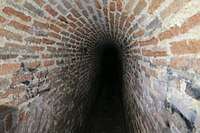
In the 17th century, the so-called "viajes de agua" (a kind of water channels or qanat) were used to provide water to the city. Some of the most important ones were the Viaje de Amaniel (1610–1621, sponsored by the Crown), the Viaje de Fuente Castellana (1613–1620) and Abroñigal Alto/Abroñigal Bajo (1617–1630), sponsored by the City Council. They were the main infrastructure for the supply of water until the arrival of the Canal de Isabel II in the mid-19th century.[88]
Madrid derives almost 73.5 percent of its water supply from dams and reservoirs built on the Lozoya River, such as the El Atazar Dam.[89] This water supply is managed by the Canal de Isabel II, a public entity created in 1851. It is responsible for the supply, depurating waste water and the conservation of all the natural water resources of the Madrid region.
Demographics
The population of Madrid has overall increased since the city became the capital of Spain in the mid-16th century, and has stabilised at approximately 3 million since the 1970s.
From 1970 until the mid-1990s, the population dropped. This phenomenon, which also affected other European cities, was caused in part by the growth of satellite suburbs at the expense of the downtown region within the city proper.
The demographic boom accelerated in the late 1990s and early first decade of the 21st century due to immigration in parallel with a surge in Spanish economic growth.
The wider Madrid region is the EU region with the highest average life expectancy at birth. The average life expectancy was 82.2 years for males and 87.8 for females in 2016.[90]
As the capital city of Spain, the city has attracted many immigrants from around the world, with most of the immigrants coming from Latin American countries.[91] In 2020, around 76 % of the registered population was Spain-born,[92] while, regarding the foreign-born population (24 %),[92] the bulk of it relates to the Americas (around 16 % of the total population), and a lesser fraction of the population is born in other European, Asian and African countries.
As of 2019 the highest rising national group of immigrants was Venezuelans.[93]
Regarding religious beliefs, according to a 2019 Centro de Investigaciones Sociológicas (CIS) survey with a sample size of 469 respondents, 20.7% of respondents in Madrid identify themselves as practising Catholics, 45.8% as non-practising Catholics, 3.8% as believers of another religion, 11.1% as agnostics, 3.6% as indifferent towards religion, and 12.8% as atheists. The remaining 2.1% did not state their religious beliefs.[94]
The Madrid metropolitan area comprises Madrid and the surrounding municipalities. According to Eurostat, the "metropolitan region" of Madrid has a population of slightly more than 6,271 million people[95] covering an area of 4,609.7 square kilometres (1,780 sq mi). It is the largest in Spain and the third largest in the European Union.[9][10][11]
Government
Local government and administration
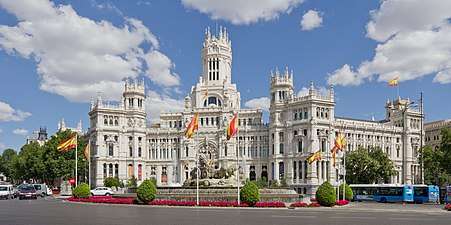
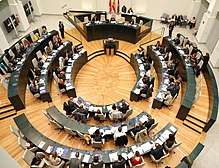
The City Council (Ayuntamiento de Madrid) is the body responsible for the government and administration of the municipality. It is formed by the Plenary (Pleno), the Mayor (alcalde) and the Government Board (Junta de Gobierno de la Ciudad de Madrid).
The Plenary of the Ayuntamiento is the body of political representation of the citizens in the municipal government. Its 57 members are elected for a 4-year mandate. Some of its attributions are: fiscal matters, the election and deposition of the mayor, the approval and modification of decrees and regulations, the approval of budgets, the agreements related to the limits and alteration of the municipal term, the services management, the participation in supramunicipal organisations, etc.[96]
The mayor, the supreme representative of the city, presides over the Ayuntamiento. He is charged with giving impetus to the municipal policies, managing the action of the rest of bodies and directing the executive municipal administration.[97] He is responsible to the Pleno. He is also entitled to preside over the meetings of the Pleno, although this responsility can be delegated to another municipal councillor. José Luis Martínez-Almeida, a member of the People's Party, serves as Mayor since 2019.
The Government Board consists of the mayor, the deputy mayor(s) and a number of delegates assuming the portfolios for the different government areas. All those positions are held by municipal councillors.[98]
Since 2007, the Cybele Palace (or Palace of Communications) serves as City Hall.
Administrative subdivisions
Madrid is administratively divided into 21 districts, which are further subdivided into 131 neighbourhoods (barrios):
| District | Population (1 Jan 2020)[99] | Area (ha) |
|---|---|---|
| Centro | 140,991 | 522.82 |
| Arganzuela | 156,176 | 646.22 |
| Retiro | 120,873 | 546.62 |
| Salamanca | 148,405 | 539.24 |
| Chamartín | 148,039 | 917.55 |
| Tetuán | 161,991 | 537.47 |
| Chamberí | 141,397 | 467.92 |
| Fuencarral-El Pardo | 250,636 | 23,783.84 |
| Moncloa-Aravaca | 122,164 | 4,653.11 |
| Latina | 242,923 | 2,542.72 |
| Carabanchel | 261,118 | 1,404.83 |
| Usera | 143,365 | 777.77 |
| Puente de Vallecas | 241,666 | 1,496.86 |
| Moratalaz | 95,907 | 610.32 |
| Ciudad Lineal | 220,598 | 1,142.57 |
| Hortaleza | 193,833 | 2,741.98 |
| Villaverde | 154,915 | 2,018.76 |
| Villa de Vallecas | 114,832 | 5,146.72 |
| Vicálvaro | 74,235 | 3,526.67 |
| San Blas-Canillejas | 161,672 | 2,229.24 |
| Barajas | 50,158 | 4,192.28 |
| Total | 3,345,894 | 60,445.51 |
Regional capital
Madrid is the capital of the Community of Madrid. The region has its own legislature and it enjoys a wide range of competencies in areas such as social spending, healthcare, education. The seat of the regional parliament, the Assembly of Madrid is located at the district of Puente de Vallecas. The presidency of the regional government is headquartered at the Royal House of the Post Office, at the very centre of the city, the Puerta del Sol.
Capital of Spain
Madrid is the capital of the Kingdom of Spain. The King of Spain, whose functions are mainly ceremonial, has their official residence in the Zarzuela Palace. As the seat of the Government of Spain, Madrid also houses the official residence of the President of the Government (Prime Minister) and regular meeting place of the Council of Ministers, the Moncloa Palace, as well as the headquarters of the ministerial departments. Both the residences of the Head of State and Government are located at the northwest of the city. Additionally, the seats of the Lower and Upper Chambers of the Spanish Parliament, the Cortes Generales (respectively, the Palacio de las Cortes and the Palacio del Senado), also lie on Madrid.
Law enforcement
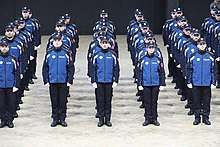
The Madrid Municipal Police (Policía Municipal de Madrid) is the local law enforcement body, dependent on the Ayuntamiento. As of 2018, it had a workforce of 6,190 civil servants.[100]
The headquarters of both the Directorate-General of the Police and the Directorate-General of the Civil Guard are located in Madrid. The headquarters of the Higher Office of Police of Madrid (Jefatura Superior de Policía de Madrid), the peripheral branch of the National Police Corps with jurisdiction over the region also lies on Madrid.
Cityscape
Architecture
Little medieval architecture is preserved in Madrid, mostly in the Almendra Central, including the San Nicolás and San Pedro el Viejo church towers, the church of San Jerónimo el Real, and the Bishop's Chapel. Nor has Madrid retained much Renaissance architecture, other than the Bridge of Segovia and the Convent of Las Descalzas Reales.

Philip II moved his court to Madrid in 1561 and transformed the town into a capital city. During the Early Hapsburg period, the import of European influences took place, underpinned by the monicker of Austrian style. The Austrian style featured not only Austrian influences but also Italian and Dutch (as well as Spanish), reflecting on the international preeminence of the Hapsburgs.[101] During the second half of the 16th-century the use of pointy slate spires in order to top structures such as church towers was imported to Spain from Central Europe.[102] Slate spires and roofs consequently became a staple of the Madrilenian architecture at the time.[103]
Stand out architecture in the city dating back to the early 17th-century includes several buildings and structures (most of them attributed to Juan Gómez de Mora) such as the Palace of the Duke of Uceda (1610), the Monastery of La Encarnación (1611–1616); the Plaza Mayor (1617–1619) or the Cárcel de Corte (1629–1641), currently known as the Santa Cruz Palace.[104] The century also saw the construction of the former City Hall, the Casa de la Villa.[105]
The Imperial College church model dome was imitated in all of Spain. Pedro de Ribera introduced Churrigueresque architecture to Madrid; the Cuartel del Conde-Duque, the church of Montserrat, and the Bridge of Toledo are among the best examples.
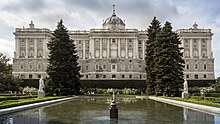
The reign of the Bourbons during the eighteenth century marked a new era in the city. Philip V tried to complete King Philip II's vision of urbanisation of Madrid. Philip V built a palace in line with French taste, as well as other buildings such as St. Michael's Basilica and the Church of Santa Bárbara. King Charles III beautified the city and endeavoured to convert Madrid into one of the great European capitals. He pushed forward the construction of the Prado Museum (originally intended as a Natural Science Museum), the Puerta de Alcalá, the Royal Observatory, the Basilica of San Francisco el Grande, the Casa de Correos in Puerta del Sol, the Real Casa de la Aduana, and the General Hospital (which now houses the Reina Sofia Museum and Royal Conservatory of Music). The Paseo del Prado, surrounded by gardens and decorated with neoclassical statues, is an example of urban planning. The Duke of Berwick ordered the construction of the Liria Palace.
During the early 19th century, the Peninsular War, the loss of viceroyalties in the Americas, and continuing coups limited the city's architectural development (Royal Theatre, the National Library of Spain, the Palace of the Senate, and the Congress). The Segovia Viaduct linked the Royal Alcázar to the southern part of town.
The list of key figures of madrilenian architecture during the 19th and 20th centuries includes authors such as Narciso Pascual y Colomer, Francisco Jareño y Alarcón, Francisco de Cubas, Juan Bautista Lázaro de Diego, Ricardo Velázquez Bosco, Antonio Palacios, Secundino Zuazo, Luis Gutiérrez Soto, Luis Moya Blanco and Alejandro de la Sota.[106]
From the mid-19th century until the Civil War, Madrid modernised and built new neighbourhoods and monuments. The expansion of Madrid developed under the Plan Castro, resulting in the neighbourhoods of Salamanca, Argüelles, and Chamberí. Arturo Soria conceived the linear city and built the first few kilometres of the road that bears his name, which embodies the idea. The Gran Vía was built using different styles that evolved over time: French style, eclectic, art deco, and expressionist. Antonio Palacios built a series of buildings inspired by the Viennese Secession, such as the Palace of Communication, the Círculo de Bellas Artes, and the Río de La Plata Bank (now Instituto Cervantes). Other notable buildings include the Bank of Spain, the neo-Gothic Almudena Cathedral, Atocha Station, and the Catalan art-nouveau Palace of Longoria. Las Ventas Bullring was built, as the Market of San Miguel (Cast-Iron style).
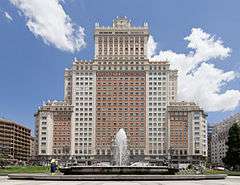
Following the Francoist takeover that ensued the end of Spanish Civil war, architecture experienced an involution, discarding rationalism and, eclecticism notwithstanding, going back to an overall rather "outmoded" architectural language, with the purpose of turning Madrid into a capital worthy of the "Immortal Spain".[107] Iconic examples of this period include the Ministry of the Air (a case of herrerian revival) and the Edificio España (presented as the tallest building in Europe when it was inaugurated in 1953).[108][107] Many of these buildings distinctly combine the use of brick and stone in the façades.[107] The Casa Sindical marked a breaking point as it was the first to reassume rationalism, although that relinking to modernity was undertaken through the imitation of the Italian Fascist architecture.[107]
With the advent of Spanish economic development, skyscrapers, such as Torre Picasso, Torres Blancas and Torre BBVA, and the Gate of Europe, appeared in the late 20th century in the city. During the decade of the 2000s, the four tallest skyscrapers in Spain were built and together form the Cuatro Torres Business Area.[109] Terminal 4 at Madrid-Barajas Airport was inaugurated in 2006 and won several architectural awards. Terminal 4 is one of the world's largest terminal areas[110] and features glass panes and domes in the roof, which allow natural light to pass through.
Parks and forests
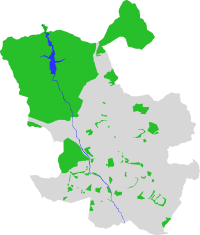
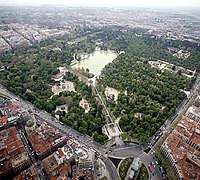
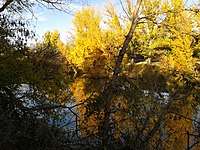
Madrid is the European city with the highest number of trees and green surface per inhabitant and it has the second highest number of aligned trees in the world, with 248,000 units, only exceeded by Tokyo. Madrid's citizens have access to a green area within a 15-minute walk. Since 1997, green areas have increased by 16%. At present, 8.2% of Madrid's grounds are green areas, meaning that there are 16 m2 (172 sq ft) of green area per inhabitant, far exceeding the 10 m2 (108 sq ft) per inhabitant recommended by the World Health Organization.
A great bulk of the most important parks in Madrid are related to areas originally belonging to the royal assets (including El Pardo, Soto de Viñuelas, Casa de Campo, El Buen Retiro, la Florida and the Príncipe Pío hill, and the Queen's Casino).[111] The other main source for the "green" areas are the bienes de propios owned by the municipality (including the Dehesa de la Villa, the Dehesa de Arganzuela or Viveros).[112]
El Retiro is the most visited location of the city.[113] Having an area bigger than 1.4 km2 (0.5 sq mi) (350 acres), it is the largest park within the Almendra Central, the inner part of the city enclosed by the M-30. Created during the reign of Philip IV (17th century), it was handed over to the municipality in 1868, after the Glorious Revolution.[114][115] It lies next to the Royal Botanical Garden of Madrid.
Located northwest of the city centre, the Parque del Oeste ("Park of the West") comprises part of the area of the former royal possession of the "Real Florida", and it features a slope as the height decreases down to the Manzanares.[116] Its southern extension includes the Temple of Debod, a transported ancient Egyptian temple.[117]
Other urban parks are the Parque de El Capricho, the Parque Juan Carlos I (both in northeast Madrid), Madrid Río, the Enrique Tierno Galván Park, the San Isidro Park as well as gardens suchs as the Campo del Moro (opened to the public in 1978)[112] and the Sabatini Gardens (opened to the public in 1931)[112] near the Royal Palace.
Further west, across the Manzanares, lies the Casa de Campo, a large forested area with more than 1700 hectares (6.6 sq mi) where the Madrid Zoo, and the Parque de Atracciones de Madrid amusement park are located. It was ceded to the municipality following the proclamation of the Second Spanish Republic in 1931.[118]
The Monte de El Pardo is the largest forested area in the municipality. A holm oak forest covering a surface over 16,000 hectares, it is considered the best preserved mediterranean forest in the Community of Madrid and one of the best preserved in Europe.[119] Already mentioned in the Alfonso XI's Libro de la montería from the mid 14th-century, its condition as hunting location linked to the Spanish monarchy help to preserve the environmental value.[119] During the reign of Ferdinand VII the regime of hunting prohibition for the Monte de El Pardo became one of full property and the expropriation of all possessions within its bounds was enforced, with dire consequences for the madrilenians at the time.[120] It is designated as Special Protection Area for bird-life and it is also part of the Regional Park of the High Basin of the Manzanares.
Other large forested areas include the Soto de Viñuelas, the Dehesa de Valdelatas and the Dehesa de la Villa. As of 2015, the most recent big park in the municipality is the Valdebebas Park. Covering a total area of 4.7 km,2 it is sub-divided in a 3.4 km2 (1.3 sq mi) forest park (the Parque Forestal de Valdebebas), a 0.8 km2 (0.31 sq mi) periurban park as well as municipal garden centres and compost plants.[121]
Economy
After it became the capital of Spain in the 16th century, Madrid was more a centre of consumption than of production or trade. Economic activity was largely devoted to supplying the city's own rapidly growing population, including the royal household and national government, and to such trades as banking and publishing.
A large industrial sector did not develop until the 20th century, but thereafter industry greatly expanded and diversified, making Madrid the second industrial city in Spain. However, the economy of the city is now becoming more and more dominated by the service sector. A major European financial center, its stock market is the third largest stock market in Europe featuring both the IBEX 35 index and the attached Latibex stock market (with the second most important index for Latin American companies).[122] It concentrates about the 75 % of banking operations in the country.[122]
Madrid is the 5th most important leading Centre of Commerce in Europe (after London, Paris, Frankfurt and Amsterdam) and ranks 11th in the world.[18] It is the leading Spanish-speaking city in terms of webpage creation.[122]
Economic history
As the capital city of the Spanish Empire from 1561, Madrid's population grew rapidly. Administration, banking, and small-scale manufacturing centred on the royal court were among the main activities, but the city was more a locus of consumption than production or trade, geographically isolated as it was before the coming of the railways.
The Bank of Spain is one of the oldest European central banks. Originally named as the Bank of San Carlos as it was founded in 1782, it was later renamed to Bank of San Fernando in 1829 and ultimately became the Bank of Spain in 1856.[123] Its headquarters are located at the calle de Alcalá. The Madrid Stock Exchange was inaugurated on 20 October 1831.[124] Its benchmark stock market index is the IBEX 35.
Industry started to develop on a large scale only in the 20th century,[125] but then grew rapidly, especially during the "Spanish miracle" period around the 1960s. The economy of the city was then centred on manufacturing industries such as those related to motor vehicles, aircraft, chemicals, electronic devices, pharmaceuticals, processed food, printed materials, and leather goods.[126] Since the restoration of democracy in the late 1970s, the city has continued to expand. Its economy is now among the most dynamic and diverse in the European Union.[127]
Present-day economy
Madrid concentrates activities directly connected with power (central and regional government, headquarters of Spanish companies, regional HQ of multinationals, financial institutions) and with knowledge and technological innovation (research centres and universities). It is one of Europe's largest financial centres and the largest in Spain.[128] The city has 17 universities and over 30 research centres.[128]:52 It is the second metropolis in the EU by population, and the third by gross internal product.[128]:69 Leading employers include Telefónica, Iberia, Prosegur, BBVA, Urbaser, Dragados, and FCC.[128]:569
The Community of Madrid, the region comprising the city and the rest of municipalities of the province, had a GDP of €220B in 2017, equating to a GDP per capita of €33,800.[129] In 2011 the city itself had a GDP per capita 74% above the national average and 70% above that of the 27 European Union member states, although 11% behind the average of the top 10 cities of the EU.[128]:237–239 Although housing just over 50% of the region's's population, the city generates 65.9% of its GDP.[128]:51 Following the recession commencing 2007/8, recovery was under way by 2014, with forecast growth rates for the city of 1.4% in 2014, 2.7% in 2015 and 2.8% in 2016.[130]:10
The economy of Madrid has become based increasingly on the service sector. In 2011 services accounted for 85.9% of value added, while industry contributed 7.9% and construction 6.1%.[128]:51 Nevertheless, Madrid continues to hold the position of Spain's second industrial centre after Barcelona, specialising particularly in high-technology production. Following the recession, services and industry were forecast to return to growth in 2014, and construction in 2015.[130]:32
Standard of living
_01.jpg)
Mean household income and spending are 12% above the Spanish average.[128]:537, 553 The proportion classified as "at risk of poverty" in 2010 was 15.6%, up from 13.0% in 2006 but less than the average for Spain of 21.8%. The proportion classified as affluent was 43.3%, much higher than Spain overall (28.6%).[128]:540–3
Consumption by Madrid residents has been affected by job losses and by austerity measures, including a rise in sales tax from 8% to 21% in 2012.[131]
Although residential property prices have fallen by 39% since 2007, the average price of dwelling space was €2,375.6 per sq. m. in early 2014,[130]:70 and is shown as second only to London in a list of 22 European cities.[132]
Employment
Participation in the labour force was 1,638,200 in 2011, or 79.0%. The employed workforce comprised 49% women in 2011 (Spain, 45%).[128]:98 41% of economically active people are university graduates, against 24% for Spain as a whole.[128]:103
In 2011, the unemployment rate was 15.8%, remaining lower than in Spain as a whole. Among those aged 16–24, the unemployment rate was 39.6%.[128]:97, 100 Unemployment reached a peak of 19.1% in 2013,[130]:17 but with the start of an economic recovery in 2014, employment started to increase.[133] Employment continues to shift further towards the service sector, with 86% of all jobs in this sector by 2011, against 74% in all of Spain.[128] In the second quarter of 2018 the unemployment rate was 10.06%.[134] :117
Services

The share of services in the city's economy is 86%. Services to business, transport & communications, property & financial together account for 52% of total value added.[128]:51 The types of services that are now expanding are mainly those that facilitate movement of capital, information, goods and persons, and "advanced business services" such as research and development (R&D), information technology, and technical accountancy.[128]:242–3
Madrid and the wider region's authorities have put a notable effort in the development of logistics infrastructure. Within the city proper, some of the standout centres include Mercamadrid, the Madrid-Abroñigal logistics centre, the Villaverde's Logistics Centre and the Vicálvaro's Logistics Centre to name a few.[135]
Banks based in Madrid carry out 72% of the banking activity in Spain.[128]:474 The Spanish central bank, Bank of Spain, has existed in Madrid since 1782. Stocks & shares, bond markets, insurance, and pension funds are other important forms of financial institution in the city.
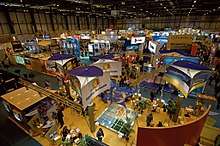
Madrid is an important centre for trade fairs, many of them coordinated by IFEMA, the Trade Fair Institution of Madrid.[128]:351–2 The public sector employs 18.1% of all employees.[128]:630 Madrid attracts about 8M tourists annually from other parts of Spain and from all over the world, exceeding even Barcelona.[128]:81[128]:362, 374[130]:44 Spending by tourists in Madrid was estimated (2011) at €9,546.5M, or 7.7% of the city's GDP.[128]:375
The construction of transport infrastructure has been vital to maintain the economic position of Madrid. Travel to work and other local journeys use a high-capacity metropolitan road network and a well-used public transport system.[128]:62–4 In terms of longer-distance transport, Madrid is the central node of the system of autovías and of the high-speed rail network (AVE), which has brought major cities such as Seville and Barcelona within 2.5 hours travel time.[128]:72–75 Also important to the city's economy is Madrid-Barajas Airport, the fourth largest airport in Europe.[128]:76–78 Madrid's central location makes it a major logistical base.[128]:79–80
Industry
As an industrial centre Madrid retains its advantages in infrastructure, as a transport hub, and as the location of headquarters of many companies. Industries based on advanced technology are acquiring much more importance here than in the rest of Spain.[128]:271 Industry contributed 7.5% to Madrid's value-added in 2010.[128]:265 However, industry has slowly declined within the city boundaries as more industry has moved outward to the periphery. Industrial Gross Value Added grew by 4.3% in the period 2003–2005, but decreased by 10% during 2008–2010.[128]:271, 274 The leading industries were: paper, printing & publishing, 28.8%; energy & mining, 19.7%; vehicles & transport equipment, 12.9%; electrical and electronic, 10.3%; foodstuffs, 9.6%; clothing, footwear & textiles, 8.3%; chemical, 7.9%; industrial machinery, 7.3%.[128]:266
The PSA Peugeot Citroën plant is located in Villaverde district.
Construction
The construction sector, contributing 6.5% to the city's economy in 2010,[128]:265 was a growing sector before the recession, aided by a large transport and infrastructure program. More recently the construction sector has fallen away and earned 8% less in 2009 than it had been in 2000.[128]:242–3 The decrease was particularly marked in the residential sector, where prices dropped by 25%–27% from 2007 to 2012/13[128]:202, 212 and the number of sales fell by 57%.[128]:216
Tourism
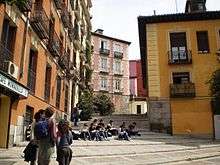
Madrid is the seat of the World Tourism Organization (UNWTO) and the International Tourism Fair (FITUR).
In 2018, the city received 10.21 million tourists (53.3% of them international tourists).[136]p. 9 The biggest share of international tourists come from the United States, followed by Italy, France, United Kingdom and Germany.[136]p. 10 As of 2018, the city has 793 hotels, 85,418 hotel places and 43,816 hotel rooms.[136]p. 18 It also had, as of 2018, an estimated 20,217 tourist apartments.[136]p. 20
The most visited museum was the Museo Nacional Centro de Arte Reina Sofía, with 3.8 million visitors in the sum of its three seats in 2018. Conversely, the Prado Museum had 2.8 million visitors and the Thyssen-Bornemisza Museum 906,815 visitors.[136]p. 32
By the late 2010s, the gentrification and the spike of tourist apartments in the city centre led to an increase in rental prices, pushing residents out of the city centre.[75] Most of the tourist apartments in Madrid (50–54%) are located in the Centro District.[137] In the Sol neighborhood (part of the latter district), 3 out of 10 homes are dedicated to tourist apartments,[137] and 2 out of 10 are listed in AirBnB.[75] In April 2019 the plenary of the ayuntamiento passed a plan intending to regulate this practice, seeking to greatly limit the number of tourist apartments. The normative would enforce a requirement for independent access to those apartments in and out of the street.[138] However, after the change of government in June 2019, the new municipal administration plans to revert the regulation.[139]
International rankings
A recent study placed Madrid 7th among 36 cities as an attractive base for business.[140] It was placed third in terms of availability of office space, and fifth for easy of access to markets, availability of qualified staff, mobility within the city, and quality of life. Its less favourable characteristics were seen as pollution, languages spoken, and political environment. Another ranking of European cities placed Madrid 5th among 25 cities (behind Berlin, London, Paris and Frankfurt), being rated favourably on economic factors and the labour market, and on transport and communication.[141]
Media and entertainment
Madrid is an important film and television production hub, whose content is distributed throughout the Spanish-speaking world and abroad. Madrid is often seen as the entry point into the European media market for Latin American media companies, and likewise the entry point into the Latin American markets for European companies.[142] Madrid is the headquarters of media groups such as Radiotelevisión Española, Atresmedia, Mediaset España Comunicación, and Movistar+, which produce numerous films, television shows and series which are distributed globally on various platforms.[143] Since 2018, the region is also home to Netflix's Madrid Production Hub, Mediapro Studio, and numerous others such as Viacom International Studios.[144][145][146][147] As of 2019, the film and television industry in Madrid employs 19,000 people (44% of people in Spain working in this industry).[148]
.jpg)
RTVE, the state-owned Spanish Radio and Television Corporation is headquartered in Madrid along with all its TV and radio channels and web services (La 1, La 2, Clan, Teledeporte, 24 Horas, TVE Internacional, Radio Nacional de España), Radio Exterior de España, Radio Clásica. The Atresmedia group (Antena 3, La Sexta, Onda Cero) is headquartered in nearby San Sebastián de los Reyes. The television network and media production company, the largest in Spain, Mediaset España Comunicación (Telecinco, Cuatro) maintains its headquarters in Fuencarral-El Pardo district. The Spanish media conglomerate PRISA (Cadena SER, Los 40 Principales, M80 Radio, Cadena Dial) is headquartered in Gran Vía street in central Madrid.
Madrid is home to numerous newspapers, magazines and publications, including ABC, El País, El Mundo, La Razón, Marca, ¡Hola!, Diario AS, El Confidencial and Cinco Días. The Spanish international news agency EFE maintains its headquarters in Madrid since its inception in 1939. The second news agency of Spain is the privately owned Europa Press, founded and headquartered in Madrid since 1953.
Art and culture
Museums and cultural centres

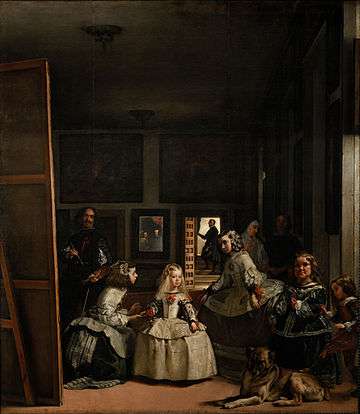
Madrid is considered one of the top European destinations concerning art museums. Best known is the Golden Triangle of Art, located along the Paseo del Prado and comprising three major museums: the Prado Museum, the Thyssen Bornemisza Museum and the Reina Sofía Museum.
The Prado Museum (Museo del Prado) is a museum and art gallery that features one of the world's finest collections of European art, from the 12th century to the early 19th century, based on the former Spanish Royal Collection. It has the best collection of artworks by Goya, Velázquez, El Greco, Rubens, Titian, Hieronymus Bosch, José de Ribera, and Patinir as well as works by Rogier van der Weyden, Raphael Sanzio, Tintoretto, Veronese, Caravaggio, Van Dyck, Albrecht Dürer, Claude Lorrain, Murillo, and Zurbarán, among others. Some of the standout works exhibited at the museum include Las Meninas, La maja vestida, La maja desnuda, The Garden of Earthly Delights, The Immaculate Conception and The Judgement of Paris.
The Thyssen-Bornemisza Museum (Museo Thyssen-Bornemisza) is an art museum that fills the historical gaps in its counterparts' collections: in the Prado's case, this includes Italian primitives and works from the English, Dutch, and German schools, while in the case of the Reina Sofía, the Thyssen-Bornemisza collection, once the second largest private collection in the world after the British Royal Collection,[149] includes Impressionists, Expressionists, and European and American paintings from the second half of the 20th century, with over 1,600 paintings.[150]
The Reina Sofía National Art Museum (Museo Nacional Centro de Arte Reina Sofía; MNCARS) is Madrid's national museum of 20th-century art. The museum is mainly dedicated to Spanish art. Highlights of the museum include excellent collections of Spain's greatest 20th-century masters, Pablo Picasso, Salvador Dalí, Joan Miró, Juan Gris, and Julio González. Certainly the most famous masterpiece in the museum is Picasso's painting Guernica, depicting the horror of war. The Reina Sofía also hosts a free-access art library.[151]
_01.jpg)
The National Archaeological Museum of Madrid (Museo Arqueológico Nacional) shows archaeological finds from Prehistory to the 19th century (including Roman mosaics, Greek ceramics, Islamic art and Romanesque art), especially from the Iberian Peninsula, distributed over three floors. An iconic item in the museum is the Lady of Elche, an Iberian bust from the 4th century BC. Other major pieces include the Lady of Baza, the Lady of Cerro de los Santos, the Lady of Ibiza, the Bicha of Balazote, the Treasure of Guarrazar, the Pyxis of Zamora, the Mausoleum of Pozo Moro or a napier's bones. In addition, the museum has a reproduction of the polychromatic paintings in the Altamira Cave.
The Royal Academy of Fine Arts of San Fernando (Real Academia de Bellas Artes de San Fernando) houses a fine art collection of paintings ranging the 15th to 20th centuries. The academy is also the headquarters of the Madrid Academy of Art.[n. 2]
CaixaForum Madrid is a post-modern art gallery in the centre of Madrid, next to the Prado Museum.[154]
The Royal Palace of Madrid, a massive building characterised by its luxurious rooms, houses rich collections of armours and weapons, as well as the most comprehensive collection of Stradivarius in the world.[155] The Museo de Colecciones Reales is a future museum intended to host the most outstanding pieces of the Royal Collections part of the Patrimonio Nacional. Located next to the Royal Palace and the Almudena, Patrimonio Nacional has tentatively scheduled its opening for 2021.[156]
The Museum of the Americas (Museo de América) is a national museum that holds artistic, archaeological, and ethnographic collections from the Americas, ranging from the Paleolithic period to the present day.[157]
Other notable museums include the National Museum of Natural Sciences (the Spain's national museum of natural history),[158] the Naval Museum,[159] the Convent of Las Descalzas Reales (with many works of Renaissance and Baroque art, and Brussels tapestries inspired by paintings of Rubens),[160] the Museum of Lázaro Galdiano (housing a collection specialising in decorative arts, featuring a collection of weapons that features the sword of Pope Innocent VIII),[161] the National Museum of Decorative Arts,[162] the National Museum of Romanticism (focused on 19th century Romanticism),[163] the Museum Cerralbo,[164] the National Museum of Anthropology (featuring as highlight a Guanche mummy from Tenerife)[165] the Sorolla Museum (focused in the namesake Valencian Impressionist painter,[166] also including sculptures by Auguste Rodin, part of Sorolla's personal effects),[167] or the History Museum of Madrid (housing pieces related to the local history of Madrid), the Wax Museum of Madrid, the Railway Museum (located in the building that was once the Delicias Station).
Major cultural centres in the city include the Fine Arts Circle (one of Madrid's oldest arts centres and one of the most important private cultural centres in Europe, hosting exhibitions, shows, film screenings, conferences and workshops), the Conde Duque cultural centre or the Matadero Madrid, a cultural complex (formerly an abattoir) located by the river Manzanares. The Matadero, created in 2006 with the aim of "promoting research, production, learning, and diffusion of creative works and contemporary thought in all their manifestations", is considered the third most valued cultural institution in Madrid among art professionals.[168]
Literature
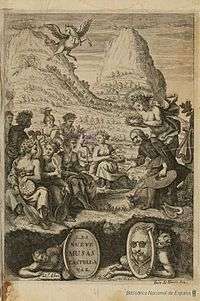
Madrid has been one of the great centres of Spanish literature. Some of the best writers of the Spanish Golden Century were born in Madrid, including: Lope de Vega (Fuenteovejuna, The Dog in the Manger, The Knight of Olmedo), who reformed the Spanish theatre, a work continued by Calderon de la Barca (Life is a Dream), Francisco de Quevedo, Spanish nobleman and writer known for his satires, which criticised the Spanish society of his time, and author of El Buscón. And finally, Tirso de Molina, who created the character Don Juan. Cervantes and Góngora also lived in the city, although they were not born there. The homes of Lope de Vega, Quevedo, Gongora and Cervantes are still preserved, and they are all in the Barrio de las Letras (District of Letters).
Other writers born in Madrid in later centuries have been Leandro Fernandez de Moratín, Mariano José de Larra, Jose de Echegaray (Nobel Prize in Literature), Ramón Gómez de la Serna, Dámaso Alonso, Enrique Jardiel Poncela and Pedro Salinas.
The "Barrio de las Letras" (Quarter of Letters) owes its name to the intense literary activity developed over the 16th and 17th centuries. Some of the most prominent writers of the Spanish Golden Age settled here, as Lope de Vega, Quevedo or Góngora, and the theatres of Cruz and Príncipe, two of the major comedy theatres of that time. At 87 Calle de Atocha, one of the roads that limit the neighbourhood, was the printing house of Juan Cuesta, where the first edition of the first part of Don Quixote (1604) was published, one of the greatest works of Spanish literature. Most of the literary routes are articulated along the Barrio de las Letras, where you can find scenes from novels of the Siglo de Oro and more recent works like "Bohemian Lights". Although born in Las Palmas de Gran Canaria, realist writer Benito Pérez Galdós is credited with making Madrid the setting for many of his stories, underpinning what has come to be known as the Madrid Galdosiano.[169]
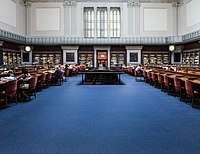
Madrid is home to the Royal Academy of Spanish Language (RAE), an internationally important cultural institution dedicated to language planning by enacting legislation aimed at promoting linguistic unity within the Hispanic states; this ensures a common linguistic standard, in accordance with its founding statutes "to ensure that the changes undergone [by the language] [...] not break the essential unity that keeps all the Hispanic".[170]
Madrid is also home to another international cultural institution, the Instituto Cervantes, whose task is the promotion and teaching of the Spanish language as well as the dissemination of the culture of Spain and Hispanic America.
The National Library of Spain is the largest major public library in Spain. The library's collection consists of more than 26,000,000 items, including 15,000,000 books and other printed materials, 30,000 manuscripts, 143,000 newspapers and serials, 4,500,000 graphic materials, 510,000 music scores, 500,000 maps, 600,000 sound recording, 90,000 audiovisuals, 90,000 electronic documents, more than 500,000 microforms, etc.[171]
Cuisine
.jpg)
The Madrilenian cuisine has received plenty of influences from other regions of Spain and its own identity actually relies in its ability to assimilate elements from the immigration.[172]
The cocido madrileño, a chickpea-based stew, is one of the most emblematic dishes of the Madrilenian cuisine.[173] The callos a la madrileña is another traditional winter specialty, usually made of cattle tripes.[174] Other offal dishes typical in the city include the gallinejas[174] or grilled pig's ear.[175] Fried squid has become a culinary specialty in Madrid, often consumed in sandwich as bocata de calamares.[174]
Other generic dishes commonly accepted as part of the Madrilenian cuisine include the potaje, the sopa de ajo (Garlic soup), the Spanish omelette, the besugo a la madrileña (bream), caracoles a la madrileña (snails, sp. Cornu aspersum) or the soldaditos de Pavía, the patatas bravas (consumed as snack in bars) or the gallina en pepitoria (hen or chicken cooked with the yolk of hard-boiled eggs and almonds) to name a few.[176][177][172]
Traditional desserts include torrijas (a variant of French toast consumed in the Easter)[174][178] and bartolillos.[177]
Nightlife
.jpg)
Madrid is reputed to have a "vibrant nightlife".[179] Some of the highlight bustling locations include the surroundings of the Plaza de Santa Ana, Malasaña and La Latina (particularly near the Cava Baja).[179] It is one of the city's main attractions with tapas bars, cocktail bars, clubs, jazz lounges, live music venues and flamenco theatres. Most nightclubs liven up by 1:30 a.m.and stay open until at least 6 a.m.[179]
Nightlife flourished in the 1980s while Madrid's mayor Enrique Tierno Galván (PSOE) was in office, nurturing the cultural-musical movement known as La Movida.[180] Nowadays, the Malasaña area is known for its alternative scene.
The area of Chueca has also become a hot spot in the Madrilenian nightlife, especially for the gay population. Chueca is known as gay quarter, comparable to The Castro district in San Francisco.[181]
Bohemian culture
The city has venues for performing alternative art and expressive art. They are mostly located in the centre of the city, including in Ópera, Antón Martín, Chueca and Malasaña. There are also several festivals in Madrid, including the Festival of Alternative Art, the Festival of the Alternative Scene.[182][183][184][185]
The neighbourhood of Malasaña, as well as Antón Martín and Lavapiés, hosts several bohemian cafés/galleries. These cafés are typified with period or retro furniture or furniture found on the street, a colourful, nontraditional atmosphere inside, and usually art displayed each month by a new artist, often for sale. Cafés include the retro café Lolina and bohemian cafés La Ida, La Paca and Café de la Luz in Malasaña, La Piola in Huertas and Café Olmo and Aguardiente in Lavapiés.
In the neighbourhood of Lavapiés, there are also "hidden houses", which are illegal bars or abandoned spaces where concerts, poetry readings and[186][187][188] the famous Spanish botellón (a street party or gathering that is now illegal but rarely stopped).
Classical music and opera
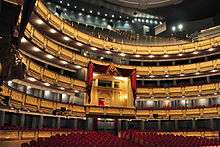
The Auditorio Nacional de Música [189] is the main venue for classical music concerts in Madrid. It is home to the Spanish National Orchestra, the Chamartín Symphony Orchestra[190] and the venue for the symphonic concerts of the Community of Madrid Orchestra and the Madrid Symphony Orchestra. It is also the principal venue for orchestras on tour playing in Madrid.
The Teatro Real is the main opera house in Madrid, located just in front of the Royal Palace, and its resident orchestra is the Madrid Symphony Orchestra.[191] The theatre stages around seventeen opera titles (both own productions and co-productions with other major European opera houses) per year, as well as two or three major ballets and several recitals.
The Teatro de la Zarzuela is mainly devoted to Zarzuela (the Spanish traditional musical theatre genre), as well as operetta and recitals.[192][193] The resident orchestra of the theatre is the Community of Madrid Orchestra.
The Teatro Monumental is the concert venue of the RTVE Symphony Orchestra.[194]
Other concert venues for classical music are the Fundación Joan March and the Auditorio 400, devoted to contemporary music.
Feasts and festivals
San Isidro
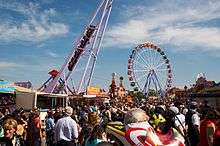
The local feast par excellence is the Day of Isidore the Laborer (San Isidro Labrador), the patron Saint of Madrid, celebrated on 15 May. It is a public holiday. According to tradition, Isidro was a farmworker and well manufacturer born in Madrid in the late 11th century, who lived a pious life and whose corpse was reportedly found to be incorrupt in 1212. Already very popular among the madrilenian people, as Madrid became the capital of the Hispanic Monarchy in 1561 the city council pulled efforts to promote his canonization; the process started in 1562.[195] Isidro was beatified in 1619 and the feast day set on 15 May[196] (he was finally canonized in 1622).[197]
On 15 May the Madrilenian people gather around the Hermitage of San Isidro and the Prairie of San Isidro (on the right-bank of the Manzanares) often dressed with checkered caps (parpusas) and kerchiefs (safos)[198] characteristic of the chulapos and chulapas, dancing chotis and pasodobles, eating rosquillas and barquillos.[199]
LGBT pride

The Madrilenian LGTB Pride has grown to become the event bringing the most people together in the city each year[200] as well as one of the most importants Pride celebrations worldwide.[201]
Madrid's Pride Parade began in 1977, in the Chueca neighbourhood, which also marked the beginning of the gay, lesbian, transgender, and bisexual rights movement after being repressed for forty years in a dictatorship.[202] This claiming of LGBT rights has allowed the Pride Parade in Madrid to grow year after year, becoming one of the best in the world. In 2007, this was recognised by the European Pride Owners Association (EPOA) when Madrid hosted Europride, the Official European Pride Parade. It was hailed by the President of the EPOA as “the best Europride in history”.[203] In 2017, Madrid celebrated the 40th anniversary of their first Pride Parade by hosting the WorldPride Madrid 2017. Numerous conferences, seminars and workshops as well as cultural and sports activities took place at the festival, the event being a “kids and family pride” and a source of education. More than one million people attended the pride's central march.[204] The main purpose of the celebration was presenting Madrid and the Spanish society in general as a multicultural, diverse, and tolerant community.[202] The 2018 Madrid Pride roughly had 1.5 million participants.[136]p. 34
Since Spain legalised same-sex marriage in July 2005,[205] Madrid has become one of the largest hot spots for LGBT culture. With about 500 businesses aimed toward the LGBT community, Madrid has become a “Gateway of Diversity”.[203]
Other

Despite often being labelled as "having no tradition" by foreigners,[206] the Carnival was popular in Madrid already in the 16th century. However, during the Francoist dictatorship the carnival was under government ban and the feasts suffered a big blow.[206][207] It has been slowly recovering since then.
Other signalled days include the regional day (2 May) commemorating the Dos de Mayo Uprising (a public holiday), the feasts of San Antonio de la Florida (13 June), the feast of the Virgen de la Paloma (circa 15 August) or the day of the co-patron of Madrid, the Virgin of Almudena (9 November), although the latter's celebrations are rather religious in nature.[208]
The most important musical event in the city is the Mad Cool festival; created in 2016, it reached an attendance of 240,000 during the three-day long schedule of the 2018 edition.[136]p. 33
Bullfighting
_05.jpg)
Madrid hosts the largest plaza de toros (bullring) in Spain, Las Ventas, established in 1929. Las Ventas is considered by many to be the world centre of bullfighting and has a seating capacity of almost 25,000. Madrid's bullfighting season begins in March and ends in October. Bullfights are held every day during the festivities of San Isidro (Madrid's patron saint) from mid May to early June, and every Sunday, and public holiday, the rest of the season. The style of the plaza is Neo-Mudéjar. Las Ventas also hosts music concerts and other events outside of the bullfighting season.
Sport
Events
_(3622888926).jpg)
The main annual international events held in Madrid are:
- Cycling:
- Vuelta a España: one of the three worldwide prestigious three-week-long Grand Tours, takes Madrid as the final stage. It takes place in the second week of September.
- Tennis:
- Madrid Open: a male and female professional tennis tournament, played on clay court. The event is part of the ATP Tour Masters 1000 and one of the top four Premier Mandatory on the WTA Tour. It is held during the first week of May.
- Davis Cup Finals: the finals of the major tournament between men's national teams, will be played from November 2019 in Madrid.
Football

Madrid is home to La Liga football club giant Real Madrid, who play their home games at the Santiago Bernabéu. The club is one of the most widely supported teams in the world and their supporters are referred to as madridistas or merengues (Meringues). Real Madrid was selected as the best club of the 20th century (FIFA Club of the Century), being the leader of the European teams ranking and the most valuable sports team in the world. Real is also the worldwide leader with a record 26 international titles.
Their successful hometown rivals, Atlético Madrid, are also well-supported in the city and play their home games at the Metropolitano Stadium. Their supporters are referred to as colchoneros (The Mattressers), in reference to the team's red and white jersey colours.[209] Atlético is considered a European elite team, having reached in the last ten seasons, three UEFA Europa League titles and two UEFA Champions League finals. Historically nationwide, Atletico has won ten Leagues and ten Cups.
Madrid has hosted four European Cup/Champions League finals at the Bernabéu, and the 2019 final was played at the Metropolitano. As well, the Bernabéu has hosted the final matches for the national teams competitions UEFA Euro 1964 and 1982 FIFA World Cup.
Basketball
Madrid boasts a main place in Spanish basketball, with two ACB clubs, both playing their home games at the Palacio de Deportes (WiZink Center). The Real Madrid's basketball section (founded in 1931) is one of the most decorated European basketball teams, having won most Euroleague throphies (10) than any other team. Madrid's other professional basketball club is Estudiantes another longstanding ACB team, founded in 1948.
Regarding international competitions, the city hosted the final matches for the 1986 and 2014 FIBA World Cups and the EuroBasket 2007, both held at the Palacio de Deportes.
Education
State Education in Spain is free, and compulsory from 6 to 16 years. The education system is called LOE (Ley Orgánica de Educación).[210]
Universities
Madrid is home to many public and private universities. Some of them are among the oldest in the world, and many of them are the most prestigious universities in Spain.
The National Distance Education University (Universidad Nacional de Educación a Distancia; UNED) has as its mission the public service of higher education through the modality of distance education. At more than 205,000 students (2015), UNED has the largest student population in Spain and is one of the largest universities in Europe. Since 1972, UNED has sought to translate into action the principle of equal opportunity in access to higher education through a methodology based on the principles of distance learning and focused on the needs of the student.

The Complutense University of Madrid (Universidad Complutense de Madrid; UCM) is the second largest university in Spain after UNED and one of the oldest universities in the world. It has over 11,000 staff members and a student population of 117,000. Most of the academic staff is Spanish. It is located on two campuses, the main one of Ciudad Universitaria in the Moncloa-Aravaca district, and the secondary campus of Somosaguas, located outside the city limits in Pozuelo de Alarcón and founded in 1971.[211][212] The Complutense University of Madrid was founded in Alcalá de Henares, old Complutum, by Cardinal Cisneros in 1499. Nevertherless, its real origin dates back to 1293, when King Sancho IV of Castile built the General Schools of Alcalá, which would give rise to Cisnero's Complutense University. During the course of 1509–1510 five schools were already operative: Artes y Filosofía (Arts and Philosophy), Teología (Theology), Derecho Canónico (Canonical Laws), Letras (Liberal Arts) and Medicina (Medicine). In 1836, during the reign of Isabel II, the University was moved to Madrid, where it took the name of Central University and was located at San Bernardo Street. Subsequently, in 1927, a new University City (Ciudad Universitaria) was planned to be built in the district of Moncloa-Aravaca, in lands handed over by the King Alfonso XIII to this purpose. The Spanish Civil War turned the University City into a war zone, causing the destruction of several schools in the area, as well as the loss of part of its rich scientific, artistic and bibliographic heritage. In 1970 the Government reformed the High Education, and the Central University became the Complutense University of Madrid. It was then when the new campus at Somosaguas was created to house the new School of Social Sciences. The old Alcalá campus was reopened as the independent UAH, University of Alcalá, in 1977. Complutense also serves to the population of students who select Madrid as their residency during their study abroad period. Students from the United States for example, might go to Madrid on a program like API (Academic Programs International) and study at Complutense for an intense immersion into the Spanish Language. After studying at the University, students return home with a fluent sense of Spanish as well as culture and diversity.[213]
The Technical University of Madrid (Universidad Politécnica de Madrid; UPM), is the top technical university in Spain. It is the result of the merge of different Technical Schools of Engineering. It shares the Ciudad Universitaria campus with the UCM, while it also owns several schools scattered in the city centre and additional campuses in the Puente de Vallecas district and in the neighbouring municipality of Boadilla del Monte.
The Autonomous University of Madrid (Universidad Autónoma de Madrid; UAM) was instituted under the leadership of the physicist, Nicolás Cabrera. The Autonomous University is widely recognised for its research strengths in theoretical physics. Known simply as La Autónoma by locals, its main site is the Cantoblanco Campus, located at the North of the municipality, close to its boundaries with the neighbouring municipalities of Alcobendas, San Sebastián de los Reyes and Tres Cantos.
Located on the main site are the Rectorate building and the Faculties of Science, Philosophy and Fine Arts, Law, Economic Science and Business Studies, Psychology, Higher School of Computing Science and Engineering, and the Faculty of Teacher Training and Education. The UAM is considered the institution to study Law in Spain,[214] The Medical School is sited outside the main site and beside the Hospital Universitario La Paz.[215]
The private Comillas Pontifical University (Universidad Pontificia Comillas; UPC) has its rectorate and several faculties in Madrid. The private Nebrija University is also based in Madrid. Some of the big public universities headquartered in the surrounding municipalities also have secondary campuses in Madrid proper: it is the case of the Charles III University of Madrid (Universidad Carlos III de Madrid; UC3M) with its main site in Getafe and an educational facility in Embajadores (after signing a deal with the regional government and the city council in 2011)[216] and the King Juan Carlos University (Universidad Rey Juan Carlos; URJC) having its main site in Móstoles and a secondary campus in Vicálvaro. The private Camilo José Cela University (Universidad Camilo José Cela; UCJC) has a postgrade school in Chamberí.
Business schools
IE Business School (formerly Instituto de Empresa) has its main campus on the border of the Chamartín and Salamanca districts of Madrid. IE Business School recently ranked #1 in WSJ's 2009 rankings for Best MBA Programs under 2 years. It scored ahead of usual stalwarts, INSEAD and IMD, giving it top billing among International MBA programs. Although based in Barcelona, both IESE Business School and ESADE Business School also have Madrid campuses. These three schools are the top-ranked business schools in Spain, consistently rank among the top 20 business schools globally, and offer MBA programs (in English or Spanish) as well as other business degrees. Madrid is a good destination for business schools and a city much desired by foreign students. The most important Spanish business schools (IESE, IE, ESADE) have invested 125 million euros in expanding their campuses in Madrid in 2020.[217]
Other Madrid business schools and universities that have MBA programs include: EAE Business School (in English and Spanish), the Charles III University of Madrid through the Centro de Ampliación de Estudios (in English or Spanish); the Comillas Pontifical University (in Spanish only) and the Technical University of Madrid (in Spanish only).
Transport
_04.jpg)
Madrid is served by several roads and three modes of public surface transport, and two airports, one of them being almost two different airports. A great many important road, rail and air links converge on the capital, providing effective connections with other parts of the metropolitan region and with the rest of Spain and other parts of Europe.
Road transport
- Madrid Central
Cars (except for hybrid and electric vehicles as well as residents and guests) were banned in the Madrid Central low-emission zone in 2018.[218][219] Pollution in the area dropped following the ban.[220][218] In 2016 it was announced that Madrid will stop the use of all diesel powered cars and trucks within the next decade.[221]
- Radial roads

Madrid is the centre of the most important roads of Spain. Already in 1720, the Reglamento General de Postas enacted by Philip V configurated the basis of a radial system of roads in the country.[222]
Madrid features a number of the most prominent autovías (fast dualled highways), part of the State Road Network. Clock-wise starting from the north: the A-1 (Madrid–Irún–French border), A-2 (Madrid–Zaragoza–Barcelona–French border), A-3 (Madrid–Valencia), A-4 (Madrid–Córdoba–Sevilla–Cádiz), A-5 (Madrid–Badajoz–Portuguese border) and the A-6 (Madrid–A Coruña). The A-42, another highway connecting Madrid to Toledo, is also part of the State Network.
The M-607 connects Madrid to the Puerto de Navacerrada. It is a fast dualled highway in its initial stretch from Madrid to Colmenar Viejo, and part of the Regional Road Network (in relation to the concerning administration, not to the technical features of the road).
Due to the large amount of traffic, new toll highways were built parallel to the main national freeways. Their names are R-2, R-3, R-4 and R-5 and they were intended to provide a paid alternative to the often overcrowded free radials. However, except the R-3, they do not end close to the M-30 innermost ring road, as the R-2 finishes in the M-40, the R-4 in the M-50 and the R-5 in the M-40.
- Orbital roads
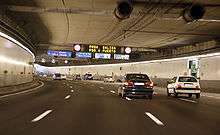
Also Madrid road network includes four orbital ones at different distances from the centre. The innermost ring-road, the M-30, is the only one with its path strictly located within the Madrid municipal limits. It is owned by the Madrid City Council and operated by Madrid Calle 30, S.A. It is the busiest Spanish road, famous for its traffic jams. A significant portion of the southern part runs underground parallel to the Manzanares, with tunnel sections of more than 6 kilometres (3.7 miles) in length and 3 to 6 lanes in each direction.
The second ring-road, the M-40 (part of the State Road Network) circles the city, while also extending to other surrounding municipalities. A NW stretch of the road runs underground, below the southern reaches of the Monte de El Pardo protected area.
The M-45 partially circles the city, connecting the M-40 and M-50, passing through areas like Villaverde and Vallecas in the South-East of the municipality.
The M-50, the Madrid's outer ring road, connects municipalities and cities in the metropolitan area, like Fuenlabrada, Móstoles, Getafe, Leganés in the South and Boadilla del Monte and Las Rozas in the West.
Public transport
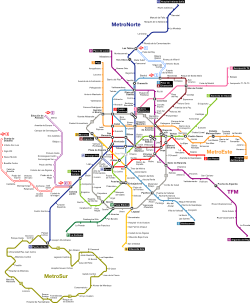
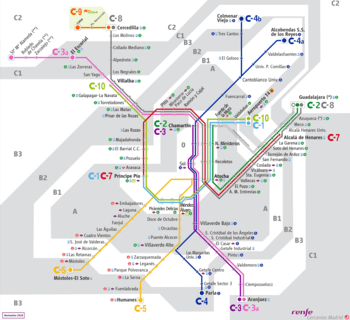
There are four major components of public transport, with many intermodal interchanges. The Consorcio Regional de Transportes de Madrid (CRTM) coordinates the public transport operations across multiple providers in the region,[223][224] harmonizing fares for the commuter rail, rapid transit, light rail and bus transport services provided by different operators.
- Metro
The Metro is the rapid transit system serving Madrid as well as some suburbs. Founded in 1919, it underwent extensive enlargement in the second half of the 20th century.[225] It is the second longest metro system in Europe (after London's) at 294 kilometres (183 miles). As of 2019, it has 302 stations.[226] Only the Métro of Paris has more stations. It features 13 lines; 12 of them are colour-coded and numbered 1 to 12 (Line 1, Line 2, Line 3, Line 4, Line 5, Line 6, Line 7, Line 8, Line 9, Line 10, Line 11 and Line 12), while the other one, the short Ramal (R), links Ópera to Príncipe Pío.[225]
- Cercanías
Cercanías Madrid is the commuter rail service used for longer distances from the suburbs and beyond into Madrid, consisting of nine lines totalling 578 kilometres (359 miles) and more than 90 stations. With fewer stops inside the centre of the city they are faster than the Metro, but run less frequently. This system is connected with Metro (presently 22 stations) and Light Metro. The lines are named: C-1, C-2, C-3, C-4, C-5, C-7, C-8, C-9, C-10, respectively.
- Buses
There is a dense network of bus routes, run by the municipal company Empresa Municipal de Transportes (or EMT Madrid), which operates 24 hours a day; special services called "N lines" are run during nighttime. The special Airport Express Shuttle line connecting the airport with the city centre features distinctively yellow buses. In addition to the urban lines operated by the EMT, the green buses (interurbanos) connect the city with the suburbs. The later lines, while also regulated by the CRTM, are often run by private operators.
Almost half of all journeys in the metropolitan area are made on public transport, a very high proportion compared with most European cities.[128]:62–4 Madrid has 15723 taxis around all the city.
- Taxi
The taxicabs are regulated by a specific sub-division of taxi service, a body dependent of the Madrid City Council. The authorisation entails a badge for the vehicle and a license for the driver, who has to be older than 18.[227] Since the 1970s, the fleet of taxis has remained stable roughly around 16,000 vehicles, accounting for 15,600 in 2014.[228]
Long-distance transport
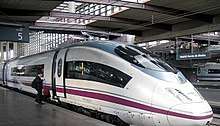
In terms of longer-distance transport, Madrid is the central node of the system of autovías, giving the city direct fast road links with most parts of Spain and with France and Portugal. It is also the focal point of one of the world's three largest high-speed rail systems, Alta Velocidad Española (AVE), which has brought major cities such as Seville and Barcelona within 2.5 hours travel time. There are now 2,900 kilometres (1,800 miles) of AVE track, connecting Madrid with 17 provincial capitals, and further lines are under construction.[128]:72–75
Also Spain business are designing new high speed trains which will be the new generation AVE 104 like Talgo AVRIL.
Aside from the local and regional bus commuting services, Madrid is also a node for long-distance bus connections to plenty of national destinations. The Estación Sur de Autobuses in Méndez Álvaro, the busiest bus station in the country,[229] also features international bus connections to cities in Morocco as well as to diverse European destinations.[229]
Airport
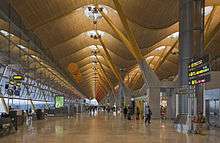
Madrid is also home to the Madrid-Barajas Airport, the sixth-largest airport in Europe, handling over 60 million passengers annually, of whom 70% are international travellers, in addition to the majority of Spain's air freight movements.[128]:76–78 Barajas is a major European hub, yet a largely westward facing one, specialized in the Americas, with a comparatively lighter connectivity to Asia.[230] Madrid's location at the centre of the Iberian Peninsula makes it a major logistics base.[128]:79–80 Madrid-Barajas Airport has 4 Terminals and also the terminal 4S, called Satellite terminal, this terminal is 2 kilometres (1.2 miles) from the terminal 4 and connected by an Automated People Mover System (AMP) train.
The smaller (and older) Cuatro Vientos Airport has a dual military-civilian use and hosts several aviation schools. The Torrejón Air Base, located in the neighbouring municipality of Torrejón de Ardoz, also has a secondary civilian use aside from the military purpose.
International relations
Diplomacy
Madrid hosts 121 foreign embassies accredited before Spain,[231] comprising all resident embassies in the country. The headquarters of the Spanish Ministry of Foreign Affairs, European Union and Cooperation, the Spanish Agency for International Development Cooperation and the Diplomatic School are also located in the city.
International organizations
Madrid hosts the seat of international organizations such as the United Nations' World Tourism Organization (UNWTO), the Ibero-American General Secretariat (SEGIB), the Organization of Ibero-American States (OEI), the International Youth Organism for Iberoamerica (OIJ), the Ibero-American Organization of Social Security (OISS), the International Organization of Securities Commissions (IOSCO), the Club of Madrid and the International Commission for the Conservation of Atlantic Tunas (ICCAT)
Twin towns and sister cities
Madrid has reached twin towns, sister city 'agreements' (acuerdos) with:[232]
- Lisbon, Portugal (1979).[232]
- Panama City, Panama (1980).[232]
- New York, United States (1982).[232]
- Malabo, Equatorial Guinea (1982).[232]
- Bordeaux, France (1984).[232][233]
- Nouakchott, Mauritania (1986).[232]
- Manila, Philippines (2005).[232]
- Sarajevo, Bosnia and Herzegovina (2007).[232]
- Abu Dhabi, United Arab Emirates (2007).[232]
- Miami, United States (2014).[232]
Madrid has reached twin towns, sister city 'minutes' (actas) with:[232]
Union of Ibero-American Capital Cities
Madrid is part of the Union of Ibero-American Capital Cities[234] establishing brotherly relations with the following cities through the issuing of a collective statement in October 1982:
- Asunción, Paraguay
- Bogotá, Colombia
- Buenos Aires, Argentina
- Caracas, Venezuela
- Guatemala City, Guatemala
- Havana, Cuba
- La Paz, Bolivia
- Lima, Peru
- Lisbon, Portugal
- Managua, Nicaragua
- Mexico City, Mexico
- Montevideo, Uruguay
- Panama City, Panama
- Quito, Ecuador
- Rio de Janeiro, Brazil
- San Jose, Costa Rica
- San Juan, Puerto Rico
- San Salvador, El Salvador
- Santiago, Chile
- Santo Domingo, Dominican Republic
- Tegucigalpa, Honduras
Other city partnerships
- Athens, Greece[232]
- Beijing, China[232]
- Belgrade, Serbia[232]
- Berlin, Germany[232][235]
- Brasilia, Brazil[232]
- Brussels, Belgium[232]
- Budapest, Hungary[232]
- Cebu City, Philippines[232]
- Chongqing, China[232]
- Davao City, Philippines[232]
- Guadalajara, Mexico[232]
- Kathmandu, Nepal[232]
- Lumbini, Nepal[232]
- Moscow, Russia[232]
- Paris, France[232]
- Prague, Czech Republic[232]
- Rome, Italy[232]
- Sofia, Bulgaria[232]
- Sucre, Bolivia[232]
- Warsaw, Poland[232]
- Zamboanga City, Philippines[232]
Partnerships with international organizations
Notable people
Honours
- Madrid Dome in Aristotle Mountains, Graham Land in Antarctica is named after the city.[236]
See also
References
- Footnotes
- Alternative pronunciations going roughly as IPA: [maˈðɾi] and [maˈðɾiθ] (

- Francisco Goya was once one of the academy's directors, and its alumni include Pablo Picasso, Salvador Dalí, Antonio López García, Juan Luna, and Fernando Botero.[152][153]
- Citations
- "History of Madrid". Madrid Traveller. Retrieved 27 August 2014.
- Municipal Register of Spain 2018. National Statistics Institute.
- "Demographia World Urban Areas" (PDF). Demographia. 2019.
- "Population on 1 January by age groups and sex - functional urban areas". Eurostat.
- "Sub-national HDI - Area Database - Global Data Lab". hdi.globaldatalab.org.
- Molina Martos, Isabel (2016). "Variación de la -/d/ final de palabra en Madrid: ¿prestigio abierto o encubierto?". Boletín de Filología. 51 (2). doi:10.4067/S0718-93032016000200013. ISSN 0718-9303.
- Salgado, Cristóbal González (2012). Eñe B1.2: der Spanischkurs. Hueber Verlag. p. 91. ISBN 978-3-19-004294-4.
- "Cifras oficiales de población resultantes de la revisión del Padrón municipal a 1 de enero". Instituto Nacional de Estadística. Retrieved 25 August 2019.
- "World Urban Areas: Population & Density" (PDF). Demographia. Retrieved 10 August 2008.
- "Major Agglomerations of the World". Population Statistics and Maps. 1 January 2019. Retrieved 25 August 2019.
- United Nations Department of Economic and Social Affairs World Urbanization Prospects (2007 revision), (United Nations, 2008), Table A.12. Data for 2007.
- "Member of the Governing Council. Delegate for Economy, Employment and Citizen Involvement" (PDF). p. 6. Retrieved 3 September 2012.
- "Madrid". Encyclopædia Britannica.
- "Global city GDP rankings 2008–2025". Pricewaterhouse Coopers. Archived from the original on 4 May 2011. Retrieved 20 November 2009.
- Globalization and World Cities (GaWC) Study Group and Network, Loughborough University. "The World According to GaWC 2010". Retrieved 12 February 2016.
- "Global Power City Index 2009" (PDF). Retrieved 14 April 2011.
- "Global Financial Centers Index".
- "Worldwide Centers of Commerce Index" (PDF). Retrieved 3 September 2012.
- "Global Power City Index" (PDF). Retrieved 3 September 2012.
- "Monocle's World's Most Liveable Cities Index 2017". Monocle.com. 10 June 2009. Archived from the original on 27 August 2013. Retrieved 18 October 2010.
- "FITUR". Archived from the original on 20 June 2012. Retrieved 17 June 2012.
- "Arte Contemporaneo en España – ARCOmadrid". Ifema.es. Retrieved 9 November 2012.
- "SIMO EDUCACIÓN - Learning Technology Exhibition - Home". www.ifema.es.
- "Cibeles Madrid Fashion Week". Archived from the original on 11 April 2012. Retrieved 27 March 2012.
- "Arquitectura. Edificios de los Museos Estatales". Mcu.es. 25 January 2012. Retrieved 7 August 2012.
- "Geography of Madrid". Easy expat. 11 August 2006.
- "Plaza de Cibeles | Spain.info in english". Spain.info. Retrieved 7 August 2012.
- "Madrid's Palacio de Cibeles Renovated Into Jaw-Dropping CentroCentro Cultural Center | Inhabitat – Sustainable Design Innovation, Eco Architecture, Green Building". Inhabitat. Retrieved 7 August 2012.
- Pérez Orozco, Santiago (2007). "El origen del topónimo Madrid" (PDF). Anales del Instituto de Estudios Madrileños. Madrid: Consejo Superior de Investigaciones Científicas. XLVII: 701–703. ISSN 0584-6374.
- Pérez Orozco 2007, p. 701.
- País, Ediciones El (13 June 2006). "Los primeros madrileños llegaron hace 500.000 años" – via elpais.com.
- "La prehistoria de Madrid". Archived from the original on 24 February 2014. Retrieved 13 March 2007.
- Ocupaciones achelenses en el valle del Jarama (Arganda, Madrid);Santonja, Manuel; López Martínez, Nieves y Pérez-González, Alfredo;1980;Diputación provincial de Madrid;ISBN 84-500-3554-6
- "Las villas romanas de Madrid. Madrid en época romana" (PDF).
- El Madrid antiguo en época romana;Fernández Palacios, Fernando;Estudios de Prehistoria y Arqueología Madrileñas;Number 13; year 2004
- Álvarez, Pilar; Sánchez, Esther (21 June 2013). "Hallado un taller paleolítico de más de 200.000 años en Vicálvaro" – via elpais.com.
- "Madrid Islámico". Nova.es. Archived from the original on 2 October 1999. Retrieved 7 August 2012.
- It was recorded in the 15th century by the Arab geographer al-Himyari, who wrote in his "The Book of the Fragrant Garden" (Kitab al-Rawd al-Mitar) about the history of the city. He describes: "Madrid, remarkable city of Al-Andalus, which was built by Amir Muhammad ibn Abd ar-Rahman..."
- "Ayuntamiento de Madrid – Alfonso VI en Madrid" (in Spanish). Madrid.es. Archived from the original on 23 July 2013. Retrieved 7 August 2012.
- Cestero Mancera, Molina Martos & Paredes García 2015, p. 18.
- Cerrillo Torquemada 2009, p. 245.
- "Ayuntamiento de Madrid – El Siglo XIII" (in Spanish). Madrid.es. Archived from the original on 23 October 2012. Retrieved 7 August 2012.
- Suárez Fernández 2001, p. 137.
- Bahamonde Magro & Otero Carvajal 1989, pp. 11–12.
- Esarte, Pedro (2001). Navarra, 1512–1530. Pamplona: Pamiela. ISBN 84-7681-340-6.
- This and other 16th- and 17th-century views of Madrid (from Frederic de Witt and Pedro Texeira) can be seen at this website
- "Ayuntamiento de Madrid – Madrid capital" (in Spanish). Madrid.es. Archived from the original on 23 July 2013. Retrieved 7 August 2012.
- Parsons 2003, p. 13.
- "Ayuntamiento de Madrid – El Madrid del Siglo de Oro" (in Spanish). Madrid.es. Archived from the original on 23 July 2013. Retrieved 7 August 2012.
- "Reales Academias" (in Spanish). Archived from the original on 21 January 2012. Retrieved 27 March 2012. Royal Academies
- "Ayuntamiento de Madrid – Madrid bajo el signo del reformismo ilustrado" (in Spanish). Madrid.es. Archived from the original on 23 July 2013. Retrieved 7 August 2012.
- "Ayuntamiento de Madrid – Madrid y la Guerra de la Independencia" (in Spanish). Madrid.es. Archived from the original on 23 July 2013. Retrieved 7 August 2012.
- "Ayuntamiento de Madrid – El Madrid liberal" (in Spanish). Madrid.es. Archived from the original on 23 July 2013. Retrieved 3 January 2013.
- Montero, Julio; Cervera Gil, Javier (2009). "Madrid en los años treinta: ambiente social, político, cultural y religioso" (PDF). Studia et Documenta: rivista dell'Istituto Storico San Josemaría Escrivá (3): 15. ISSN 1970-4879.
- Montero & Cervera Gil 2009, p. 16.
- Montero & Cervera Gil 2009, p. 17.
- Montero & Cervera Gil 2009, p. 20.
- Montero & Cervera Gil 2009, p. 21.
- Montero & Cervera Gil 2009, p. 25; 26.
- Montero & Cervera Gil 2009, p. 26.
- Heras, Beatriz de las; Peláez, José Manuel (2018). "Mujeres en y para una guerra. España, 1936-1939. La mirada del fotógrafo Santos Yubero, cronista gráfico de Madrid". Fotografía y patrimonio cultural: V, VI, y VII Encuentros en Castilla-La Mancha (in Spanish). Ediciones de la Universidad de Castilla La Mancha. p. 505. ISBN 978-84-9044-333-0.
- "Madrid, de territorio fronterizo a región metropolitana. Madrid, from being the "frontier" to become a Metropole". History of Madrid. (in Spanish). Luis Enrique Otero Carvajal (Profesor Titular de Historia Contemporánea. Universidad Complutense. Madrid). Archived from the original on 18 December 2007. Retrieved 28 October 2007.
- García Ballesteros & Revilla González 2006, p. 16.
- García Ballesteros & Revilla González 2006, pp. 17–18.
- Faraldo & Rodríguez-López 2019, pp. 107–124.
- López Simón 2018, p. 175.
- López Simón 2018, p. 175; 178.
- López Simón 2018, pp. 179–180.
- Carretero, Nacho (October 2018). "Quinquis: un vistazo rápido a las barriadas españolas de los 80". Jot Down.
- "Obras, túneles y casticismo". El Mundo. Retrieved 6 February 2020.
- Llamas, Manuel (9 September 2013). "El sueño olímpico costó 2.000 euros a cada contribuyente madrileño". Libre Mercado (in Spanish). Retrieved 6 February 2020.
- Masterson-Algar 2016, p. 30.
- Jiménez Barrado, Víctor; Sánchez Martín, José Manuel (2016). "Banca privada y vivienda usada en la ciudad de Madrid" (PDF). Investigaciones Geográficas (66): 43–58. doi:10.14198/INGEO2016.66.03. ISSN 0213-4691.
- "Una casa de apuestas cada 100 metros: el juego se ceba en barrios pobres de Madrid". El Español (in Spanish). 2 January 2019. Retrieved 6 February 2020.
- Aunión, J.A.; Clemente, Yolanda (26 February 2018). "How tourist apartments are hurting Madrid's neighborhoods". El País.
- Fraguas, Rafael (3 March 2007). "Siete colinas bajo el asfalto". El País.
- Gonzalo Muñoz, A; González Doncel, I. "Estudio de la cartografía antigua de El Monte de El Pardo". VII Congreso Forestal Español. Plasencia: Sociedad Española de Ciencias Forestales. p. 1. ISBN 978-84-941695-2-6.
- Revisión del plan general. Memoria. Tomo III. Información urbanística. Diagnóstico de ciudad (PDF). 2. Ayuntamiento de Madrid. 15 November 2013. p. 166.
- "Climate: Madrid - Temperature, Climate graph, Climate table - Climate-Data.org". climate-data.org.
- J. Klausen. "GAWSIS 2.2". MeteoSwiss. Retrieved 3 January 2013.
- Meteorología, Agencia Estatal de. "Extreme values. Madrid Airport". Agencia Estatal de Meteorología (in Spanish). Retrieved 25 August 2019.
- "Valores climatológicos normales. Madrid, Retiro)". AEMet. 2018. Retrieved 6 March 2018.
- "Extreme Values (Jan–Apr), Madrid". AEMet. Retrieved 12 February 2016.
- "Extreme Values (May–Aug), Madrid". AEMet. Retrieved 12 February 2016.
- "Extreme Values (Sep–Dec), Madrid". AEMet.
- "Guía resumida del clima en España (1981–2010)". AEMet. Archived from the original on 6 September 2014.
- "Monthly weather forecast and climate - Madrid, Spain". Weather Atlas. Retrieved 20 June 2020.
- Pinto Crespo, Virgilio (2010). "Introducción". Los viajes de agua de Madrid durante el antiguo régimen (PDF). Madrid: Fundación Canal. pp. 7–9. ISBN 978-84-932119-6-7.
- "HISTORIALIA – Presa de El Atazar. Madrid". historialia.com.
- "Population statistics at regional level - Statistics Explained". ec.europa.eu.
- "Crece un 6% la población extranjera en Madrid hasta llegar al 21,5%". Telemadrid. 10 August 2018.
- "Población por País de nacimiento" (.xslx). Ayuntamiento de Madrid. Retrieved 7 July 2020.
- Cano, Luis (17 April 2019). "El éxodo venezolano empuja a Madrid a su récord histórico de población extranjera". ABC.
- CIS (July 2019). "Postelectoral Elecciones Autonómicas y municipales 2019. Madrid (Municipio de)" (PDF). Retrieved 14 September 2019.
- "Eurostat – Tables, Graphs and Maps Interface (TGM) table". Epp.eurostat.ec.europa.eu. 2 April 2012. Retrieved 9 November 2012.
- "Pleno de Madrid (Spanish Only)" (in Spanish). Munimadrid.es. Retrieved 13 April 2010.
- "Ley 22/2006, de 4 de julio, de Capitalidad y de Régimen Especial de Madrid" (PDF). Boletín Oficial del Estado. p. 13.
- "Local Government Organization (Spanish Only)" (in Spanish). Munimadrid.es. Retrieved 13 April 2010.
- "Población por distrito y barrio". Banco de datos. Ayuntamiento de Madrid.
- Barroso, Francisco Javier (18 December 2018). "618 policías de la capital se podrán jubilar por un cambio en la ley". www.elpais.com. El País.
- Escobar, Jesús (2007). "Arquitectura y urbanismo en el Madrid del siglo XVII: proceso, adorno y experiencia". Arquitectura y espacio urbano en Madrid en los siglos XVII y XVIII (PDF). Ayuntamiento de Madrid. p. 54.
- Estepa Gómez, Raimundo (2015). Chapiteles del siglo XVI al XVIII en Madrid y su entorno: sus armaduras de madera (PDF). Madrid: Universidad Politécnica de Madrid. p. 4.
- "Arquitectura en el Madrid de los Austrias". Ediciones La Librería. 18 January 2016.
- Blasco Esquivias 2016, p. 280.
- Escobar 2007, p. 60–63.
- García Gutiérrez-Mosteiro, Javier (1996). "Diez arquitectos en Madrid" (PDF). Madrid y sus arquitectos: 150 años de la escuela de arquitectura. Madrid: Dirección General del Patrimonio Cultural de la Comunidad de Madrid. pp. 75–96. ISBN 84-89162-73-5.
- Torrús, Alejandro (13 January 2017). "La huella del fascismo patrio en la arquitectura de Madrid". Público.
- Méndez, Julián (23 February 2011). "Un símbolo en el centro de Madrid". Hoy.
- "La altura sí importa". Architecture (in Spanish). Retrieved 18 September 2018.
- "Madrid Barajas International Airport (MAD/LEMD) - Airport Technology". Airport Technology. Retrieved 27 March 2018.
- Galiana Martín 1994, pp. 46; 50.
- Galiana Martín 1994, p. 50.
- "El Retiro cumple 150 años en manos del pueblo de Madrid". Cadena COPE. 6 November 2018.
- Galiana Martín 1994, p. 48.
- Fraser, Benjamin (2007). "Madrid's Retiro Park as publicly-private space and the spatial problems of spatial theory". Social & Cultural Geography. Taylor & Francis. 8 (5): 684. CiteSeerX 10.1.1.917.6601. doi:10.1080/14649360701633212. ISSN 1464-9365.
- Valenzuela Rubio, Manuel (1977). "Aportaciones a una geografía del esparcimiento en Madrid: Los espacios verdes" (PDF). Rutas de Butano. Madrid: Universidad Autónoma de Madrid. Departamento de Geografía (28): 39–40. Archived from the original (PDF) on 16 September 2019.
- Remón Menéndez, Juan F. (1998). "Nature and the city: the Parque del Oeste and the expansion of nineteenth-century Madrid". Urban History. 25 (2): 210. doi:10.1017/s0963926800000808.
- Galiana Martín, Luis (1994). "Las propiedades territoriales de la Corona y su incidencia en el desarrollo urbano en Madrid" (PDF). CT: Catastro. Dirección General del Catastro (21): 50. ISSN 1138-3488.
- Tomé, Francisco Javier; Muñoz Rodríguez, Ángel (2011). "Monte de El Pardo: Un monte ligado a la historia" (PDF). Foresta (52): 312–314. ISSN 1575-2356.
- Galiana Martín 1994, p. 46.
- "Los grandes parques de Madrid que oxigenan la vida en la gran ciudad". ABC. 26 March 2015.
- Moreno-Fernández, Francisco (2020). "Local and global elements of Spanish in Madrid". In Lynch, Andrew (ed.). The Routledge Handbook of Spanish in the Global City. Oxon & New York: Routledge. ISBN 978-1-138-86066-7.
- Martín-Aceña, Pablo (2017). "The Banco de España, 1782-2017. The history of a central bank" (PDF). Estudios de Historia Económica (73): 1.
- "Fechas clave en la historia de la Bolsa de Madrid". www.eleconomista.es. El Economista. 20 October 2006.
- Juliá, S. et al. (1995), Madrid, Historia de una capital
- "Overview: Economy of Madrid". EasyExpat. 16 August 2006.
- Nota de coyuntura: economía de Madrid, Becker, Bellido y Fernández (2006)
- Estructura Economica de le Ciudad de Madrid, Ayuntamiento de Madrid (Madrid City Council), August 2013
- "Regional GDP per capita ranged from 31% to 626% of the EU average in 2017". eurostat. Retrieved 25 June 2020.
- "Barómetro de Economía de la Ciudad de Madrid, No. 41" (PDF). Madrid City Council. October 2014. Archived from the original (PDF) on 28 January 2015. Retrieved 25 January 2015.
- "Madrid Nightlife Has Lost a Bit of Its Magic". UMCI News. Archived from the original on 29 March 2015. Retrieved 23 January 2015.
- A comparison of UK and European cities", City Mayors, 21 February 2013
- "Spanish Jobless Figure Drops as Economy Picks Up." The Gazette (Colorado Springs, CO). The Gazette (Colorado Springs, CO). 2014. Retrieved 23 January 2015 from HighBeam Research: http://www.highbeam.com/doc/1P2-37308642.html Archived 29 March 2015 at the Wayback Machine
- "El paro bajó en Madrid el 10,06% en el segundo trimestre" La Vanguardia. Retrieved 18 September 2018: https://www.lavanguardia.com/local/madrid/20180726/451110311856/paro-madrid-baja-1006-trimestre.html
- Orjuela Castro, Javier Arturo; Castro Ocampo, Óscar Fernando; Suspes Bulla, Edwin Andrés (2005). "Operadores y plataformas logísticas" (PDF). Tecnura. Bogotá: Universidad Distrital Francisco José de Caldas. 8 (16). doi:10.14483/22487638.6249. ISSN 0123-921X.
- "Anuario de Turismo. Madrid. 2018" (PDF). www.madrid-destino.com. Madrid Destino.
- Pérez Mendoza, Sofía (24 October 2017). "Tres factores que convierten a Lavapiés en un área vulnerable al aumento de pisos turísticos". eldiario.es.
- Rodríguez-Pina, Gloria (27 March 2019). "El Ayuntamiento de Madrid aprueba la normativa que cerrará más de 10.000 pisos turísticos". El País.
- Belver, Marta (31 August 2019). "Almeida estudia eliminar la exigencia de que los pisos turísticos en Madrid tengan un acceso diferenciado al de los vecinos". El Mundo.
- Cushman & Wakefield, European Cities Monitor, 2011
- Ramos, A. (2013): Ranking de ciudades europeas 2012, Barómetro de Economía de la Ciudad de Madrid. No. 35
- "La productora argentina Azteka Films abrirá oficina en Madrid a finales de año" (in Spanish). Audiovisual451. 10 September 2019. Retrieved 25 June 2020.
- de Pablo, Emiliano (20 May 2019). "Madrid Region Booms as an International Production Hub". Variety. Retrieved 25 June 2020.
- Medina, Miguel Ángel (21 September 2019). "Cuando Clint Eastwood mataba forajidos en la sierra de Madrid" (in Spanish). El País. Retrieved 25 June 2020.
- Clover, Julian (5 December 2018). "Amazon chooses Madrid for European production hub". www.broadbandtvnews.com. Retrieved 25 June 2020.
- Vicente, Adrien (18 July 2019). "Madrid emerges as TV series production hub". The Jakarta Post. Retrieved 25 June 2020.
- "DAZN abre en Madrid un centro de producción virtual" (in Spanish). Audiovisual451. 19 September 2019. Retrieved 25 June 2020.
- Cortés, Helena (7 April 2019). "España, la nueva meca industrial de la televisión" (in Spanish). ABC. Retrieved 25 June 2020.
- Kandell, Jonathan (28 April 2002). "Baron Thyssen-Bornemisza, Industrialist Who Built Fabled Art Collection, Dies at 81". The New York Times. Retrieved 7 August 2012.
- "Thyssen-Bornemisza Museum (English)". Museo Nacional Thyssen-Bornemisza.
- "Museo Reina Sofía (MNCARS), official English webpage". Museoreinasofia.es. Archived from the original on 1 January 2013. Retrieved 3 January 2013.
- "The Real Academia de Bellas Artes de San Fernando Museum, Madrid". Gomadrid.com. Retrieved 14 April 2011.
- "WICHITA STATE UNIVERSITY SCULPTURE TOUR – Wichita State University". wichita.edu.
- "Caixaforum Madrid | Nuestros centros | Obra Social "la Caixa"". Obrasocial.lacaixa.es. 15 January 1974. Archived from the original on 16 April 2016. Retrieved 3 January 2013.
- "Patrimonio Nacional - Palacio Real de Madrid". Archived from the original on 12 January 2013. Retrieved 26 February 2011.
- Riaño, Peio H. (5 November 2019). "Patrimonio Nacional invierte 900.000 euros en apuntalar las Colecciones Reales". El País.
- "Museo de América". Museodeamerica.mcu.es. Retrieved 1 June 2011.
- "Portada". MNCN. 27 May 2011. Retrieved 2 June 2011.
- "INICIO MUSEO NAVAL MADRID – Museo Naval – Armada Española – Ministerio de Defensa – Gobierno de España" (in Spanish). Armada.mde.es. Retrieved 3 January 2013.
- "Patrimonio Nacional – Monasterio de las Descalzas Reales". Patrimonionacional.es. Archived from the original on 14 April 2011. Retrieved 14 April 2011.
- "Fundación Lázaro Galdiano museum website". Flg.es. Archived from the original on 2 July 2011. Retrieved 14 April 2011.
- "Museo de Artes Decorativas". Mnartesdecorativas.mcu.es. Retrieved 1 June 2011.
- "Museo del Romanticismo". Museoromanticismo.mcu.es. Retrieved 1 June 2011.
- "Museo Cerralbo". Museo Cerralbo. Retrieved 1 June 2011.
- "Museo Nacional de Antropología". Mnantropologia.mcu.es. Retrieved 1 June 2011.
- "Sorolla Museum". Madrid Official Tourism Website. Retrieved 12 March 2019.
- "Museo Sorolla". Museo Sorolla. Retrieved 1 June 2011.
- "Matadero Madrid, la tercera institución cultural mejor valorada del país". El País. 10 March 2014.
- García-Posada, Miguel (2005). Guía del Madrid galdosiano (PDF) (2nd ed.). pp. 11–12. ISBN 978-84-451-3131-2.
- "Real Decreto 1109/1993, de 9 de julio, por el que se aprueba los Estatutos de la Real Academia Española". Noticias.juridicas.com. 21 January 2011. Retrieved 14 April 2011.
- España, Biblioteca Nacional de (21 May 2013). "Colecciones". bne.es.
- "La cocina madrileña más castiza". Cinco Días. 6 May 2006.
- Morales García, Teresa (15 November 2016). "Date un homenaje: los cinco guisos de puchero más calóricos". El País (in Spanish). ISSN 1134-6582. Retrieved 5 February 2020.
- Madridiario. "Descubre la comida típica de Madrid". Madridiario (in Spanish). Retrieved 5 February 2020.
- Hermida, Álvaro (17 November 2019). "Los mejores sitios para comer oreja a la plancha en Madrid". Alimente. El Confidencial.
- Feo Parrondo, Francisco (2014). "Jornadas de turismo gastronómico en la Comunidad de Madrid". Cuadernos de Turismo. Murcia: Universidad de Murcia (33): 32. ISSN 1139-7861.
- Dávalos, Carlos (7 May 2016). "Un acercamiento a la gastronomía madrileña". Crónica Global.
- Vallejo, Verónica. "Los placeres de la cocina madrileña: 4 recetas que lo demuestran". Alimente. El Confidencial.
- Benavides Canepa, Jessica (13 July 2017). "Madrid after dark: How to go out like the locals". cnn.com.
- Minchot, Pia (2002). Madrid, Metropolis. A. Asppan S.L. p. 21. ISBN 978-84-89439-89-4.
- Richardson, Paul (16 March 2012). "Madrid: the best nights out". The Guardian.
- MSO.net - http://www.mso.net. "Things to do in Madrid – Popular sightseeing activities & things to do in Madrid". Directline-citybreaks.co.uk. Archived from the original on 8 June 2010. Retrieved 14 June 2010.
- "11 Festival Escena Contemporánea". Escenacontemporanea.com. Archived from the original on 19 December 2010. Retrieved 14 June 2010.
- "Festival Alternativo de las Artes Escénicas, Madrid, Spain – Things to Do Reviews". NileGuide.com. Retrieved 14 June 2010.
- El Mundo. "El Mundo – Art Madrid ¿Alternativo o complementario a ARCO?". elmundo.es. Retrieved 27 August 2014.
- "Madrid's Bohemian Best: Exploring Lavapiés – La Castiza". En.momondo.com. Retrieved 14 June 2010.
- "Madrid Neighbourhoods: Lavapiés... Going out, eating, drinking, and bohemian cool! – Notes from Madrid – Tapas bars, restaurants, shopping, and nightlife in Madrid". Notesfrommadrid.com. 15 November 2007. Archived from the original on 21 May 2010. Retrieved 14 June 2010.
- "El Rastro & Lavapiés". Whatmadrid.com. Retrieved 14 June 2010.
- "Auditorio Nacional de Música". Time Out. Archived from the original on 5 September 2009. Retrieved 19 August 2009.
- "Orquesta Sinfónica Chamartín-Historia (in Spanish)". Orquesta Sinfónica Chamartín. 20 February 2008. Archived from the original on 14 May 2013. Retrieved 28 August 2008.
- "Teatro Real (Timeout Madrid)". Archived from the original on 5 September 2009. Retrieved 31 January 2009.
- "History". mcu.es.
- "Teatro de la Zarzuela – Timeout Madrid". Timeout.com. Archived from the original on 8 September 2009. Retrieved 13 April 2010.
- "La Orquesta Sinfónica (in Spanish)". RTVE. Retrieved 27 August 2014.
- Zozaya, Leonor (30 June 2011). "Construcciones para una canonización: reflexiones sobre los lugares de memoria y de culto en honor a San Isidro Labrador". Revista electrónica de Historia Moderna (in Spanish). 7 (22). ISSN 1699-7778.
- Río Barredo, María José del (1993). "Fiestas públicas en Madrid (1561-1808)". Madrid: Universidad Autónoma de Madrid: 105. Cite journal requires
|journal=(help) - "¿Por qué se celebra San Isidro el 15 de mayo?". La Sexta (in Spanish). 15 May 2017. Retrieved 3 February 2020.
- "'Parpusas', 'safos' y 'mañosas'". El País. 15 May 1989.
- Atienza, Jara (14 May 2019). "Estos son los platos que debes probar en San Isidro". La Vanguardia.
- "El Orgullo 2011 se pone los cascos en Chueca". El País. 28 June 2011.
- León, Pablo (7 July 2016). "El Orgullo más envidiado del mundo". El País.
- "About WPM 2017 – Madrid Pride MADO'15". www.madridorgullo.com. Archived from the original on 14 November 2016. Retrieved 14 November 2016.
- "About Madrid Pride – Madrid Pride MADO'15". www.madridorgullo.com. Retrieved 14 November 2016.
- "Más de un millón de personas convierten a Madrid en capital mundial del Orgullo Gay". heraldo.es (in Spanish). 1 July 2017. Retrieved 30 July 2019.
- Mclean, Renwick (1 July 2005). "Spain gives approval to gay unions". The New York Times. ISSN 0362-4331. Retrieved 14 November 2016.
- Alpuente, Moncho (13 February 2002). "Tradición". El País.
- Cruz, Luis de la (6 March 2011). "Pequeña historia del carnaval madrileño | Somos Malasaña". somosmalasana.eldiario.es (in Spanish). Retrieved 3 February 2020.
- "Descubre todas las actividades que te ofrecen las fiestas de la Almudena 2019". La Vanguardia. 9 November 2019.
- "Madridista or Colchonero?". goal.com.
- "Sistema Educativo LOE by the Spanish Ministry of Education(Spanish Only)", Retrieved 8 March 2016
- Morales Matos, Guillermo; Marías Martínez, Daniel (2009). "Universidad y territorio en el área metropolitana de Madrid" (PDF). Ería. University of Oviedo. 80: 190. ISSN 0211-0563.
- "Universidad Complutense". Missouri-St. Louis University. 10 July 2006. Archived from the original on 3 July 2006.
- "Complutense University of Madrid". UCM. Archived from the original on 16 March 2011.
- ""El Mundo" 50 Carreras 2008". Elmundo.es. Retrieved 3 January 2013.
- "Universidad Autónoma". Universidad Autónoma de Madrid. 10 July 2006. Archived from the original on 5 September 2004.
- "La Universidad Carlos III gestionará desde enero todo el Mercado de Puerta de Toledo". Madridiario. 28 December 2014.
- Sánchez-Silva, Carmen (16 February 2020). "Las escuelas de negocios expanden sus redes en Madrid". El País (in Spanish). ISSN 1134-6582. Retrieved 20 February 2020.
- O'Sullivan, Feargus. "In Madrid, a Car Ban Proves Stronger Than Partisan Politics". CityLab.
- "Spanish judge blocks Madrid council bid to lift car ban". 16 July 2019 – via www.reuters.com.
- Valverde, Por Brenda (24 June 2019). "Los efectos de Madrid Central: disminuye la contaminación en todas las estaciones".
- McGrath, Matt (2 December 2016). "Four major cities move to ban diesel vehicles by 2025". BBC News. Retrieved 2 December 2016.
- Teran, Fernando de. "Movilidad, comunicaciones y riegos en el entorno del Madrid borbónico". Madrid y los Borbones en el siglo XVIII. La construcción de una ciudad y su territorio (PDF). Madrid: Consejería de Cultura, Deportes y Turismo de la Comunidad de Madrid. p. 64. ISBN 84-505-0871-1.
- Vassallo, José Manuel; Pérez de Villar, Pablo; Muñoz‐Raskin, Ramón; Serebrisky, Tomás (2009). "Public Transport Funding Policy in Madrid: Is There Room for Improvement?". Transport Reviews. 29 (2): 265. doi:10.1080/01441640802383214. ISSN 0144-1647.
- "Ley de creación del Consorcio Regional de Transportes Públicos Regulares de Madrid" [Law for the Creation of the Regional Consortium of Regular Public Transport for Madrid] (in Spanish). Retrieved 25 June 2015.
- Sultana, Selima; Weber, Joe (18 April 2016). Minicars, Maglevs, and Mopeds: Modern Modes of Transportation Around the World: Modern Modes of Transportation around the World. ABC-CLIO. p. 179. ISBN 9781440834950.
- Pérez, Susana (2 April 2019). "Cien años de la vida subterránea de Metro de Madrid". Madridiario.
- Skok, Walter; Martinez, Juan Antonio (2010). "An international taxi cab evaluation: Comparing Madrid with London, New York, and Paris". Knowledge and Process Management. 17 (3): 145–153. doi:10.1002/kpm.346.
- "Los gastos y los ingresos de los taxistas profesionales". El Economista. 19 September 2014.
- García Gallo, Bruno (11 October 2013). "La estación Sur se moderniza". El País.
- Horton, Will (5 November 2019). "IAG Makes Madrid Barajas Airport A Pawn In Air Europa Acquisition". Forbes.com.
- "Presencia de España en el mundo" (PDF). Atlas nacional de España. Instituto Geográfico Nacional. 2019. p. 585.
- "Hermanamientos y Acuerdos con ciudades". Ayuntamiento de Madrid.
- "Bordeaux – Rayonnement européen et mondial". Mairie de Bordeaux (in French). Archived from the original on 7 February 2013. Retrieved 29 July 2013.
- "Declaración de Hermanamiento múltiple y solidario de todas las Capitales de Iberoamérica (12–10–82)" (PDF). 12 October 1982. Archived from the original (PDF) on 10 May 2013. Retrieved 12 March 2015.
- "City Partnership Madrid". State of Berlin and the BerlinOnline Stadtportal GmbH & Co. KG. Retrieved 23 February 2019.
- Madrid Dome. SCAR Composite Antarctic Gazetteer.
- Bibliography
- Bahamonde Magro, Ángel; Otero Carvajal, Luis Enrique (1989). Madrid, de territorio fronterizo a región metropolitana (PDF). Madrid: Espasa Calpe.
- Blasco Esquivias, Beatriz (2016). "Invención, traza y proyecto. El proceso arquitectónico en las "Obras reales" de la Casa de Austria" (PDF). Artigrama: Revista del Departamento de Historia del Arte de la Universidad de Zaragoza. Zaragoza: Universidad de Zaragoza (31): 279–306. ISSN 0213-1498.
- Cerrillo Torquemada, Irene (2009). "Aproximación a la regulación del espacio rural madrileño en el tránsito de la Edad Media a la Moderna". Cuadernos de Historia del Derecho. Madrid: Ediciones Complutense. 16: 217–273. ISSN 1133-7613.
- Cestero Mancera, Ana M.; Molina Martos, Isabel; Paredes García, Florentino. "El estudio sociolingüístico de Madrid". In Cestero Mancera, Ana M.; Molina Martos, Isabel; Paredes García, Florentino (eds.). Patrones sociolingüísticos de Madrid. 21. Bern: Peter Lang. pp. 17–62. ISBN 978-3-0343-1638-5.
- Faraldo, José M.; Rodríguez-López, Carolina (2019). "La reconstrucción de Madrid y de Varsovia desde 1939/1945: diferencias estructurales y similitudes orgánicas". In Michonneau, Stéphane; Rodríguez-López, Carolina; Vela Cossío, Fernando (eds.). Huellas, reconstrucción, patrimonio (1939-años 2000). Madrid: Casa de Velázquez; Ediciones Complutense. pp. 107–124.
- García Ballesteros, José Ángel; Revilla González, Fidel (2006). El Madrid de la posguerra (PDF). Madrid: UMER. Archived from the original (PDF) on 23 June 2020.
- López Simón, Iñigo (2018). "El chabolismo vertical: los movimientos migratorios y la política de vivienda franquista (1955-1975)" (PDF). Huarte de San Juan. Geografía e historia. Pamplona: Universidad Pública de Navarra (25): 173–192. ISSN 1134-8259.
- Masterson-Algar, Araceli (2016). Ecuadorians in Madrid: migrants' place in urban history. New York, NY: Palgrave Macmillan. ISBN 978-1-137-53606-8.
- Parsons, Deborah L. (2003). A cultural history of Madrid : modernism and the urban spectacle. Oxford & New York: Berg. ISBN 1-85973-646-7.
- Suárez Fernández, Luis (2001). "Madrid, de simple ciudadela a Villa real". In López Gómez, Antonio (ed.). Madrid desde la Academia. Madrid: Real Academia de la Historia. pp. 113–148. ISBN 84-89512-81-7.

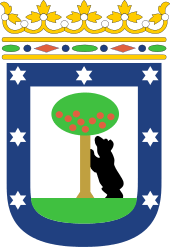
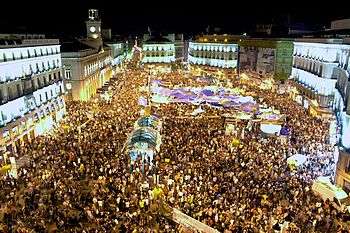

.jpg)
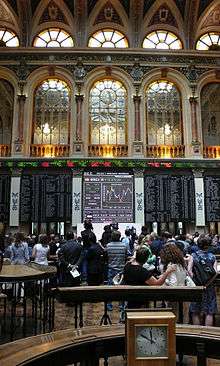
.jpg)
